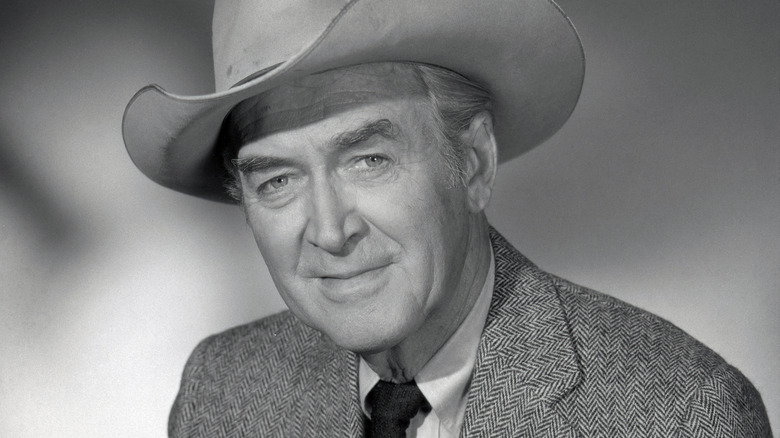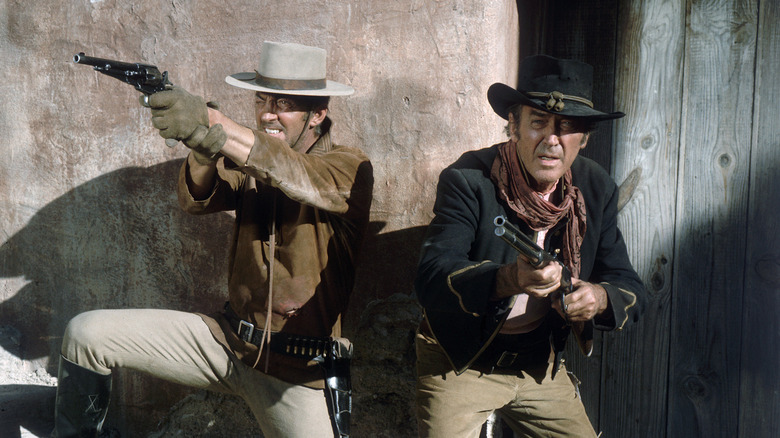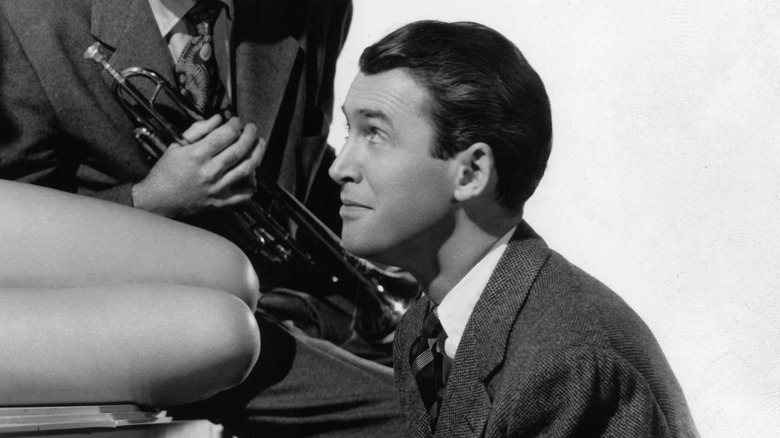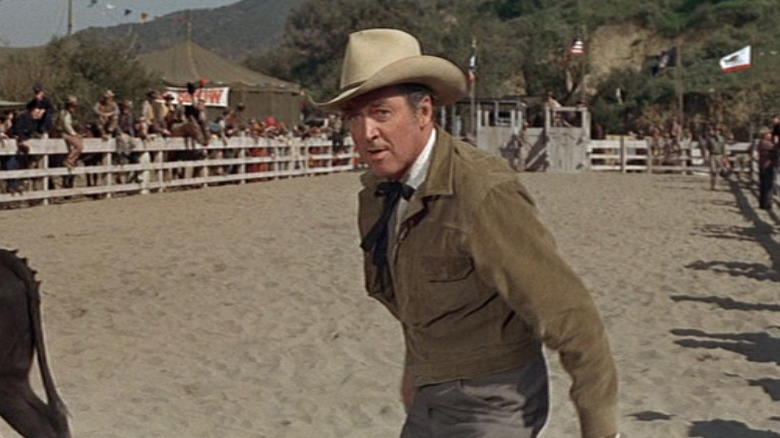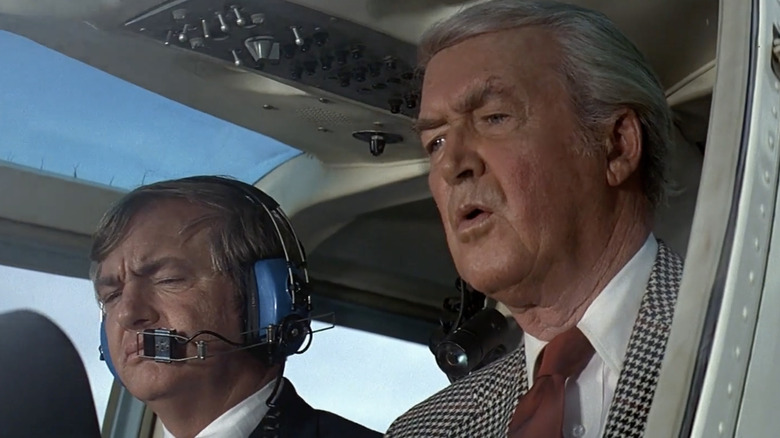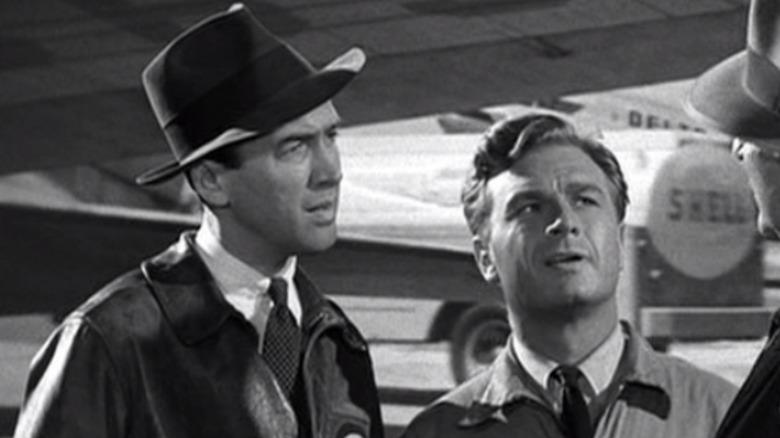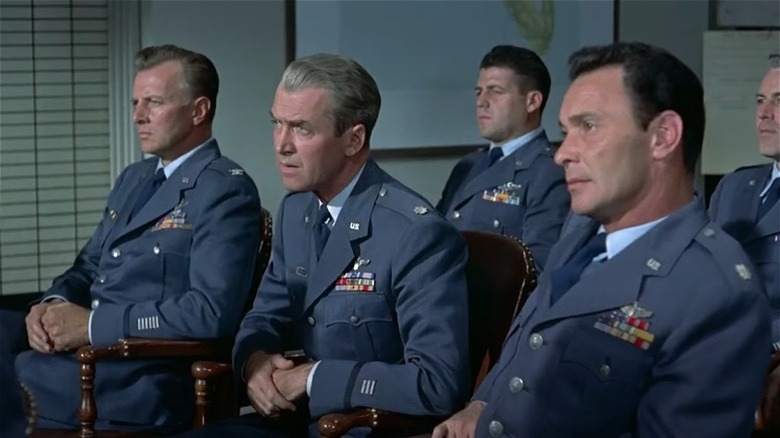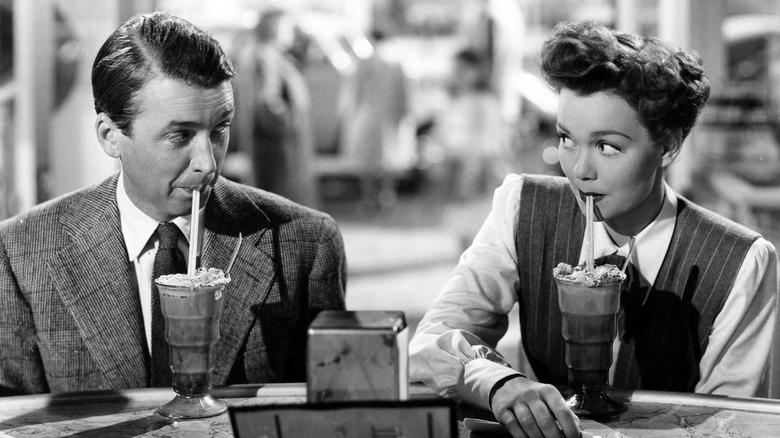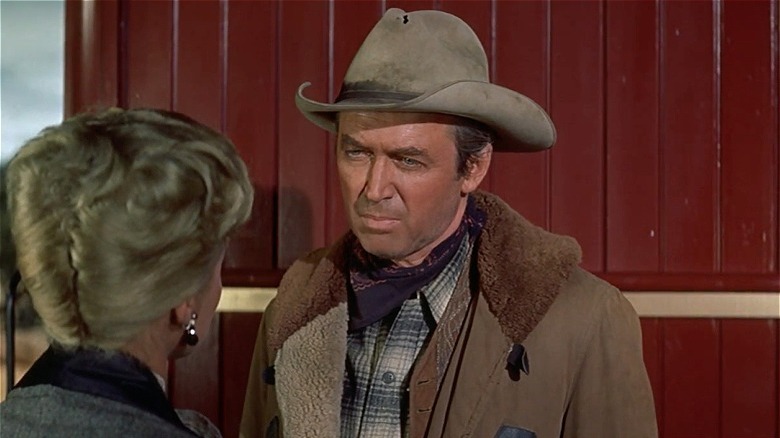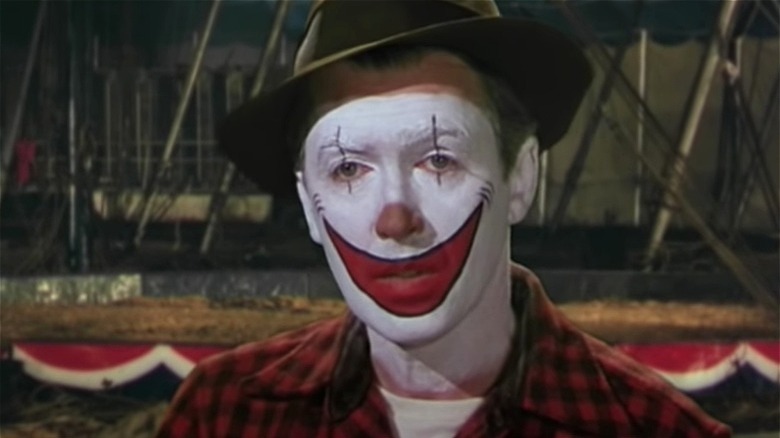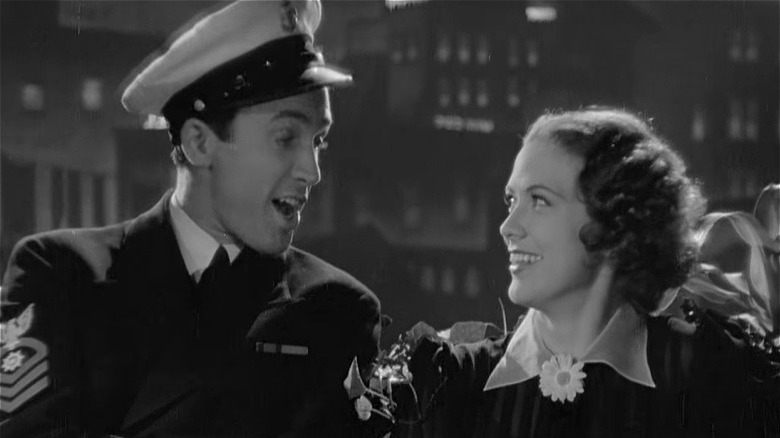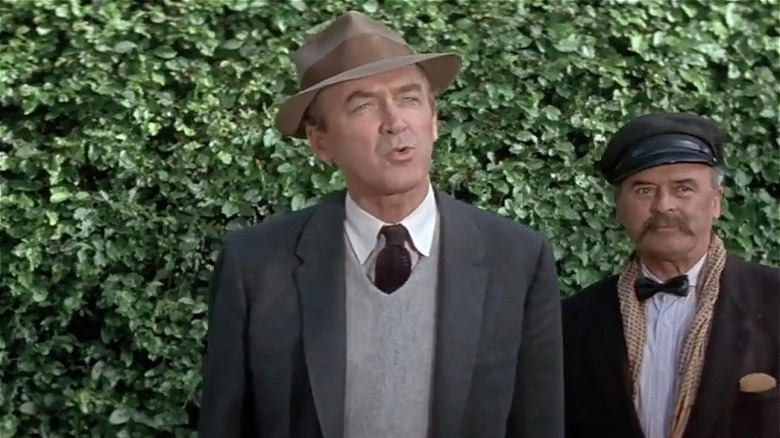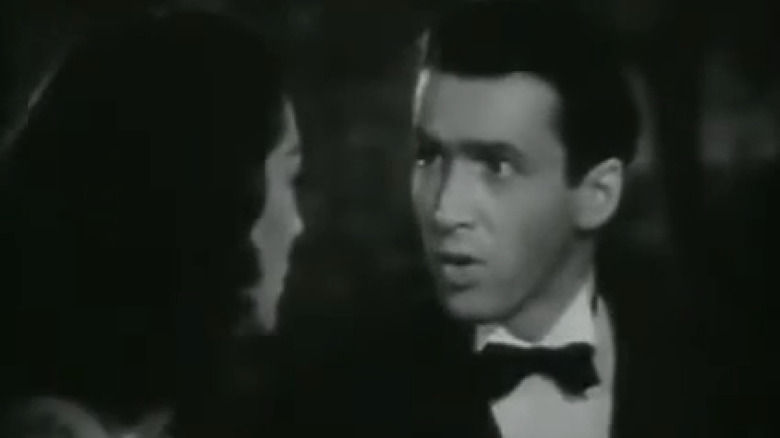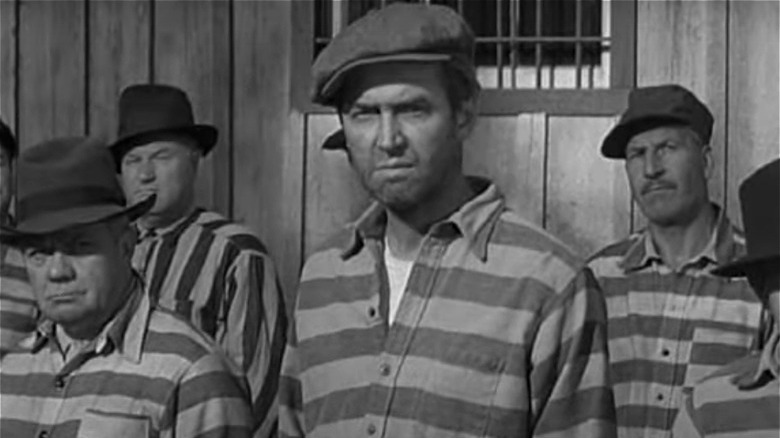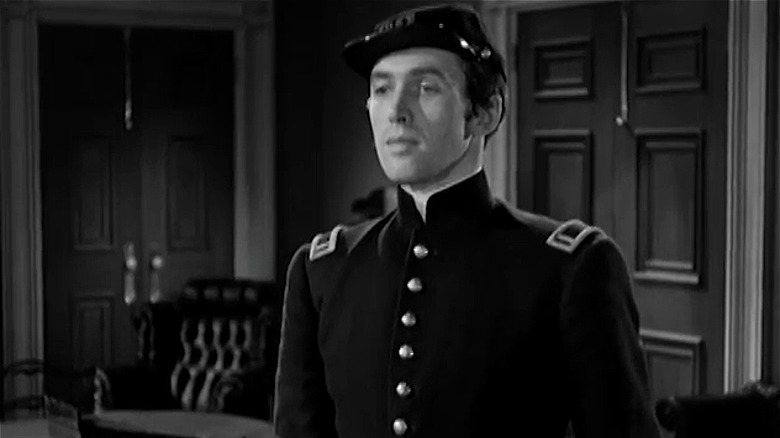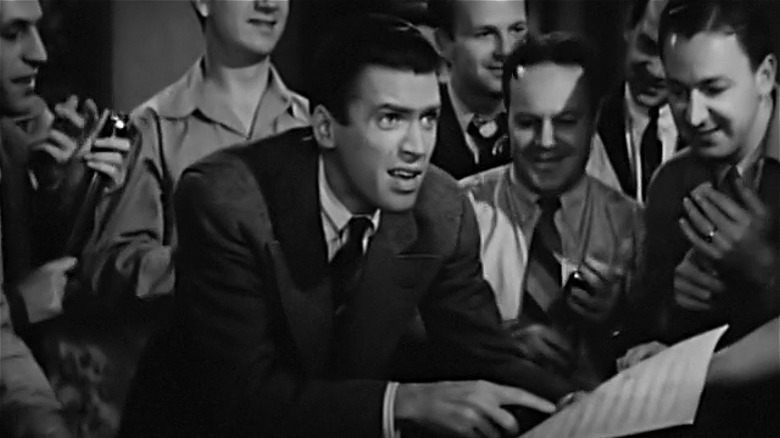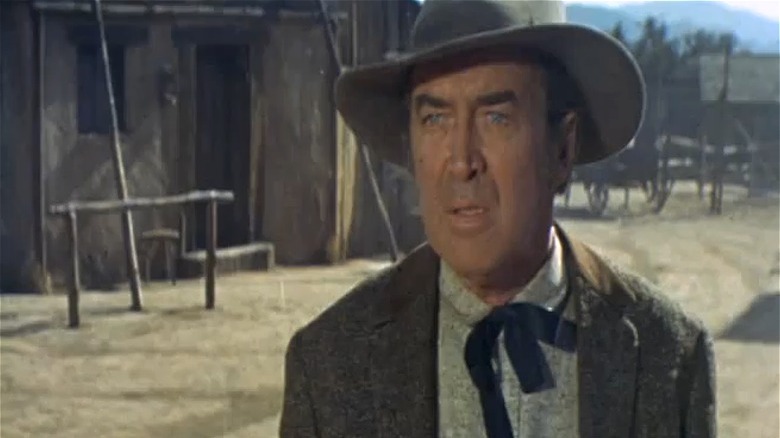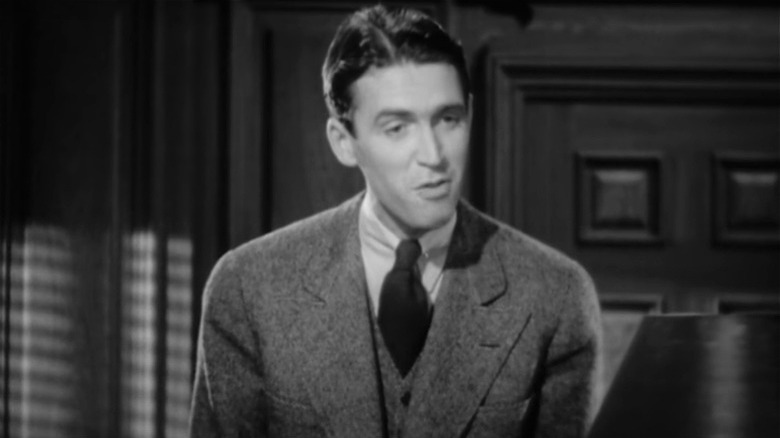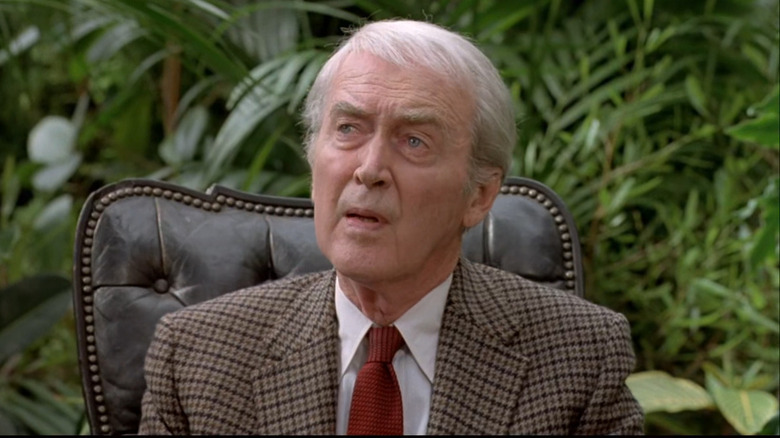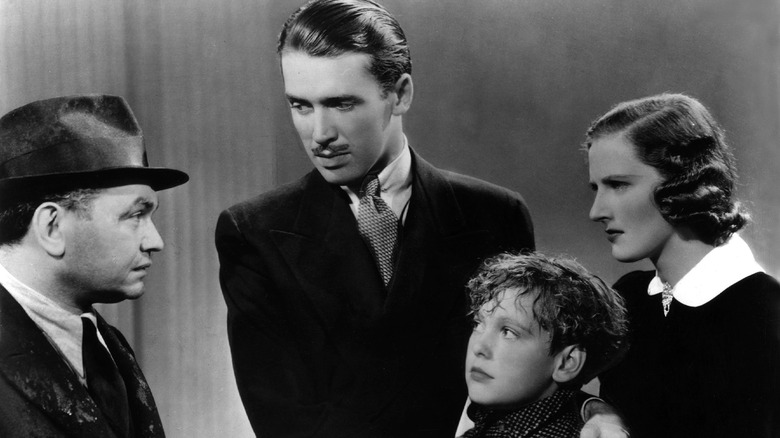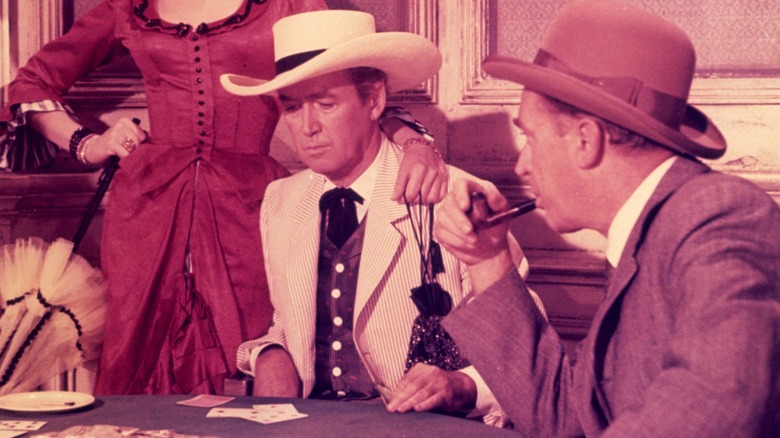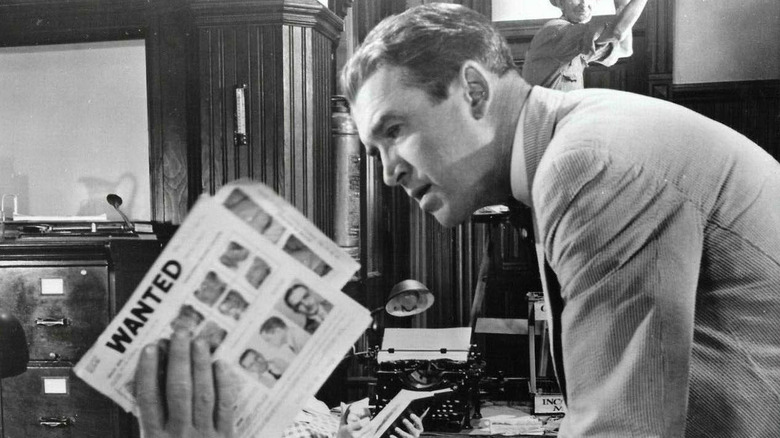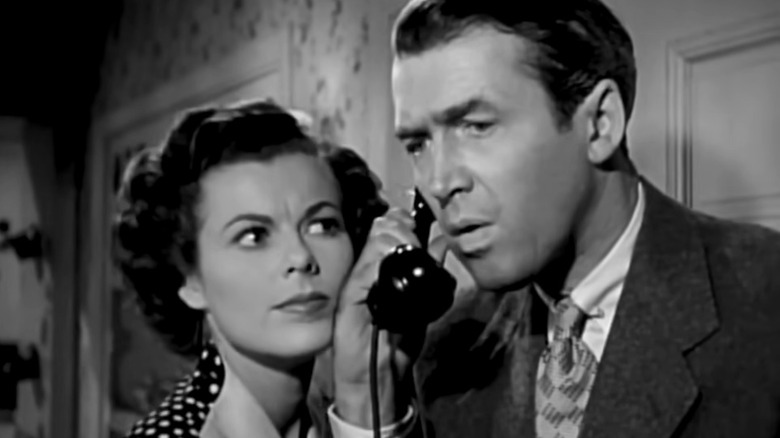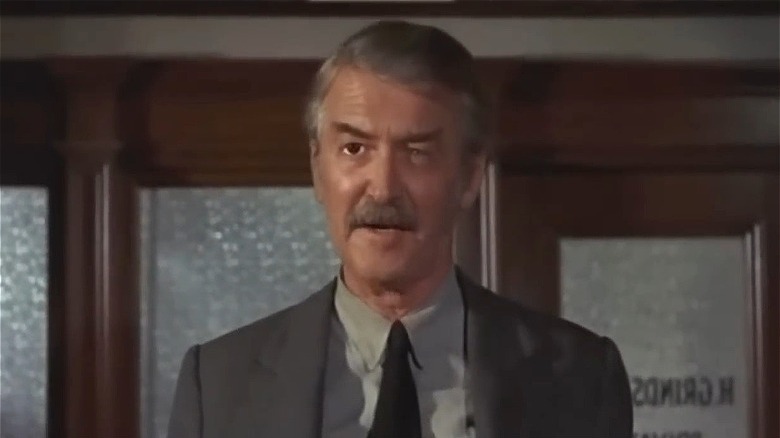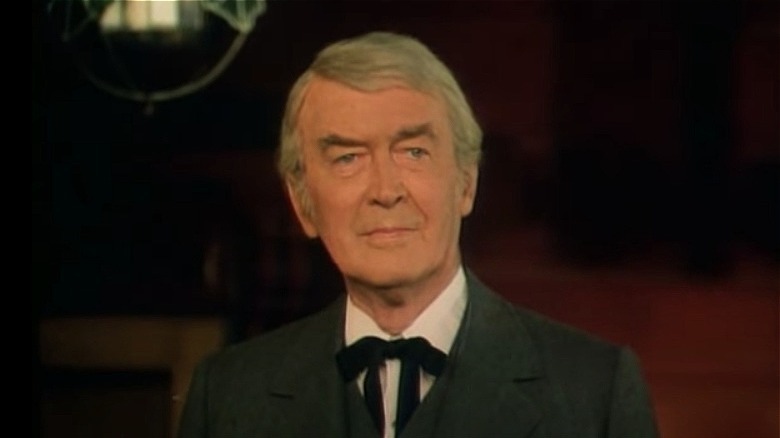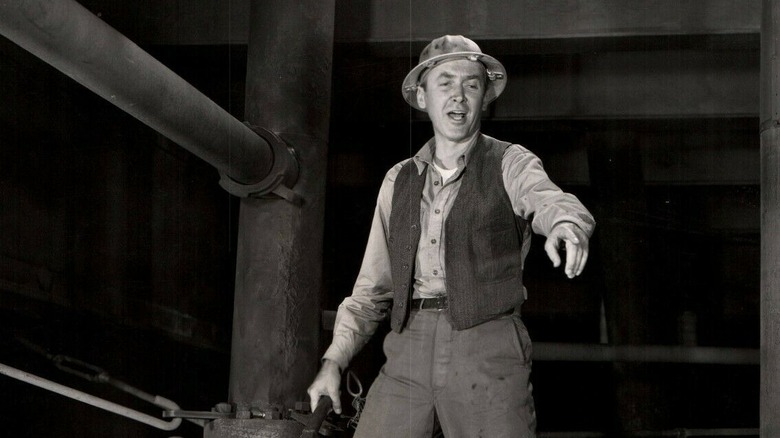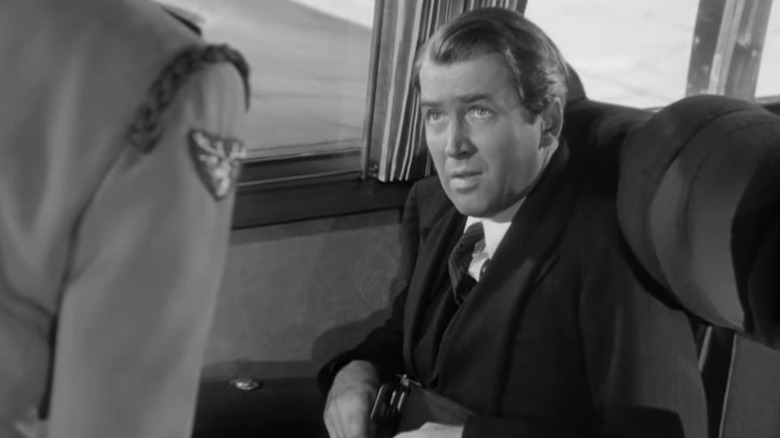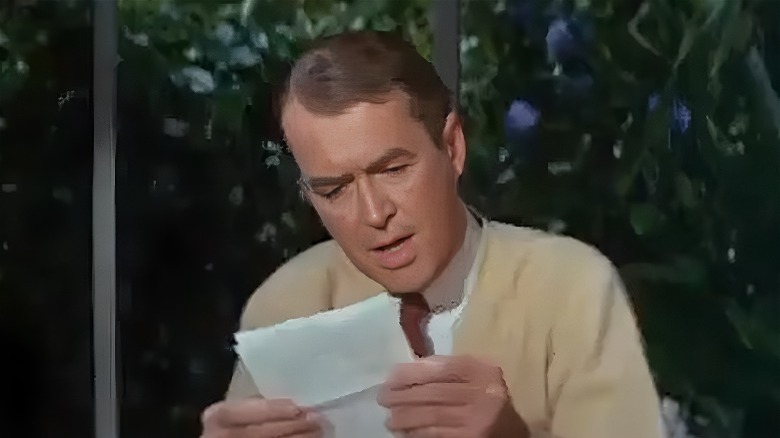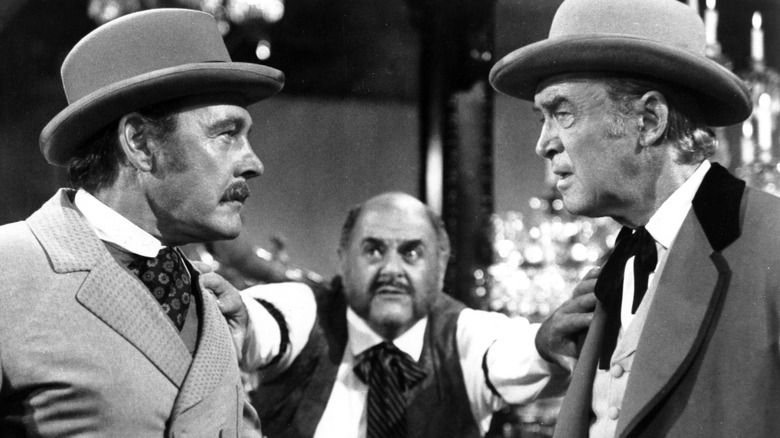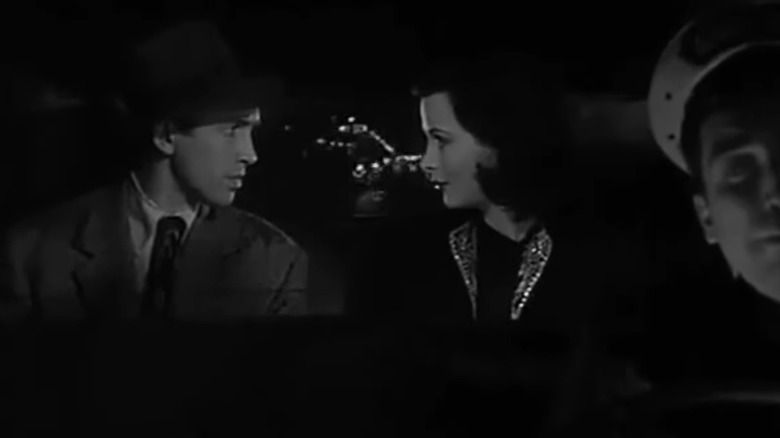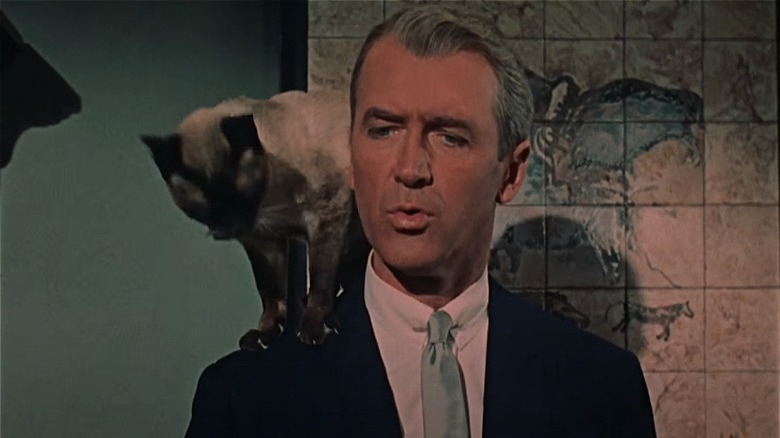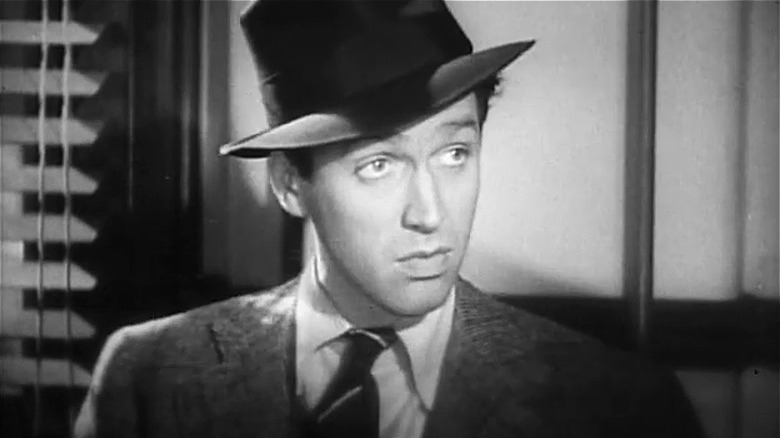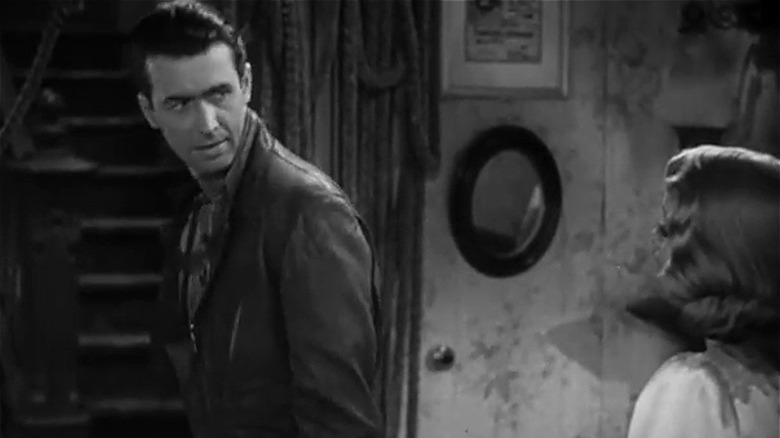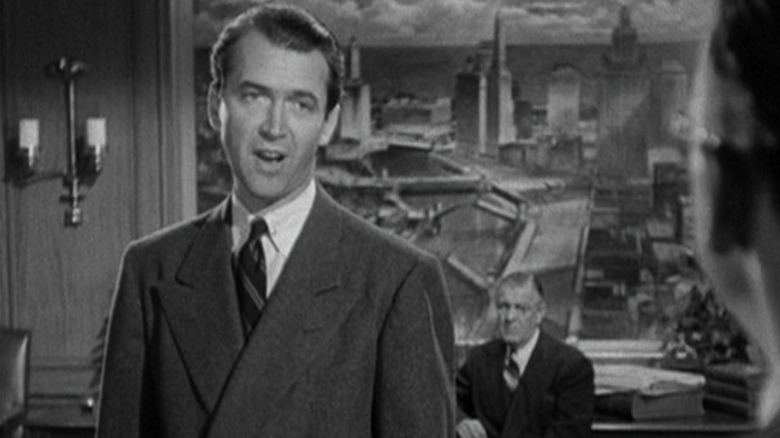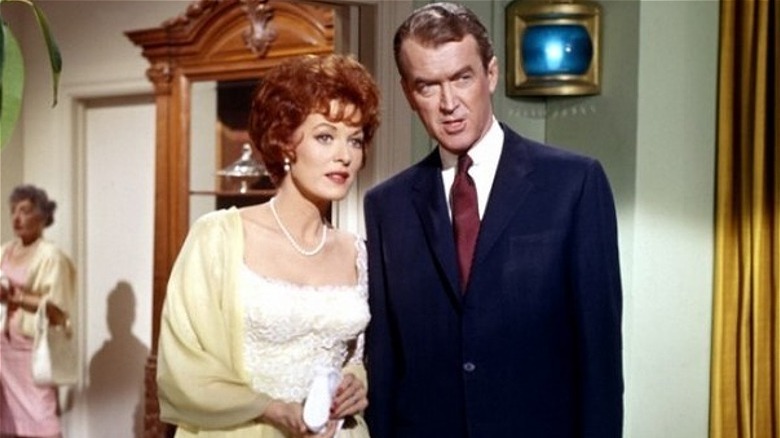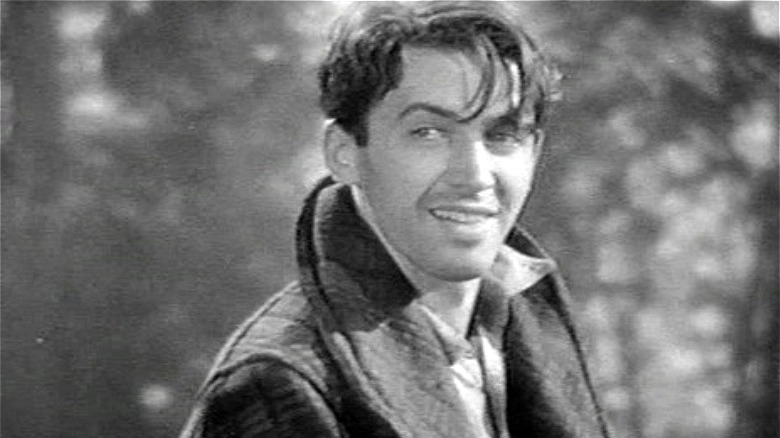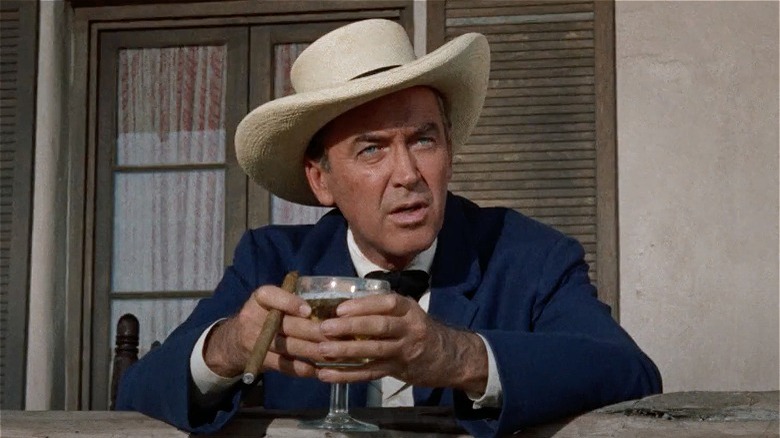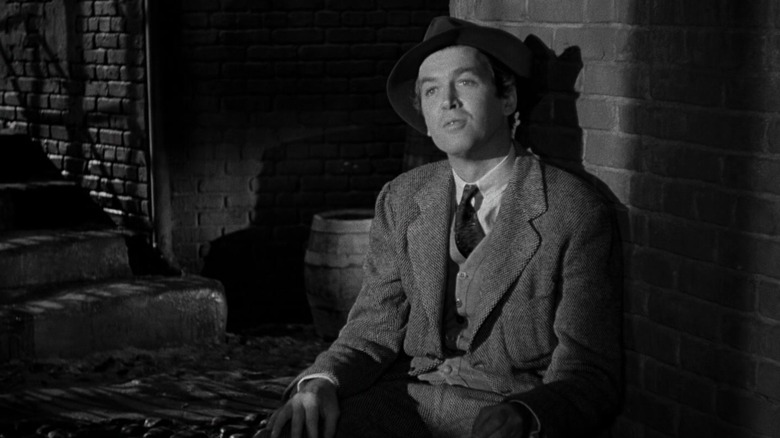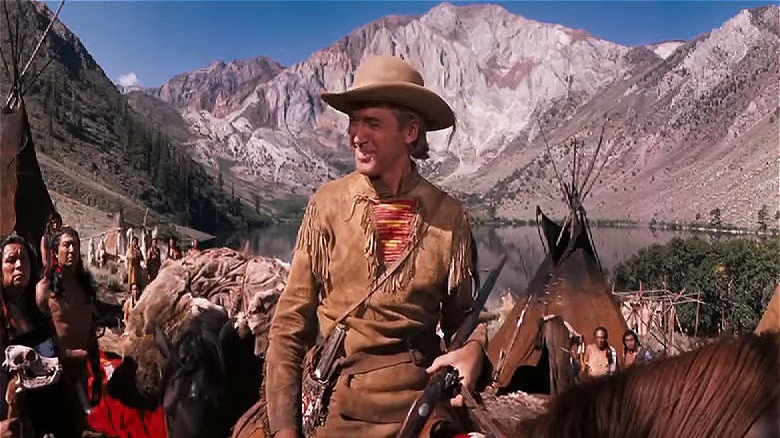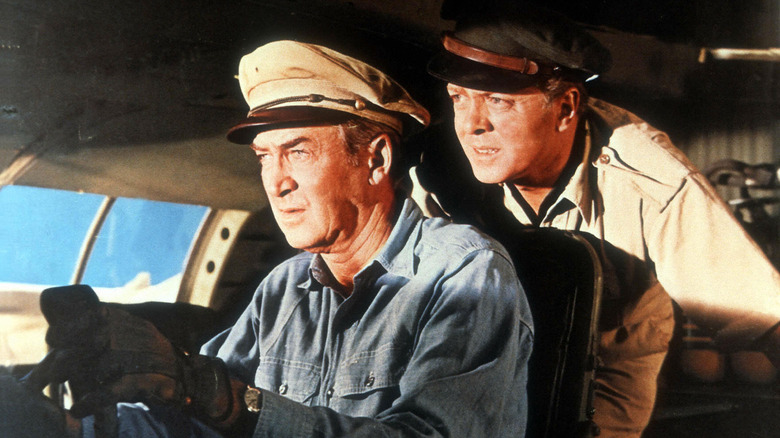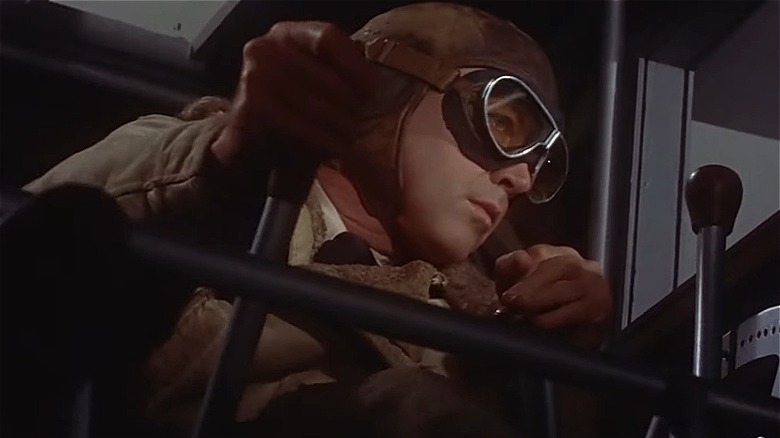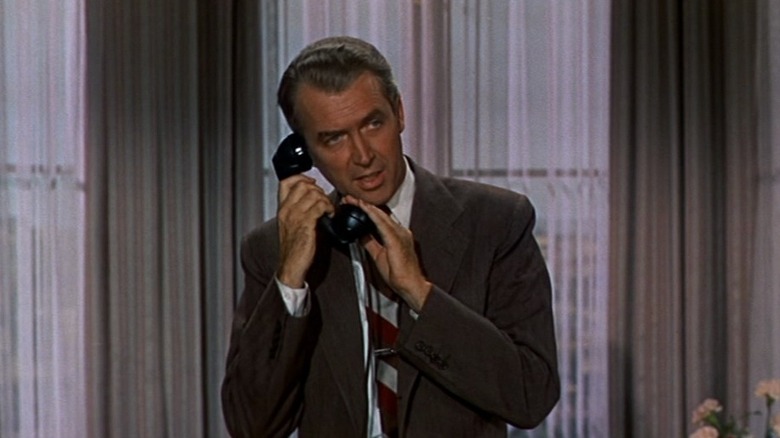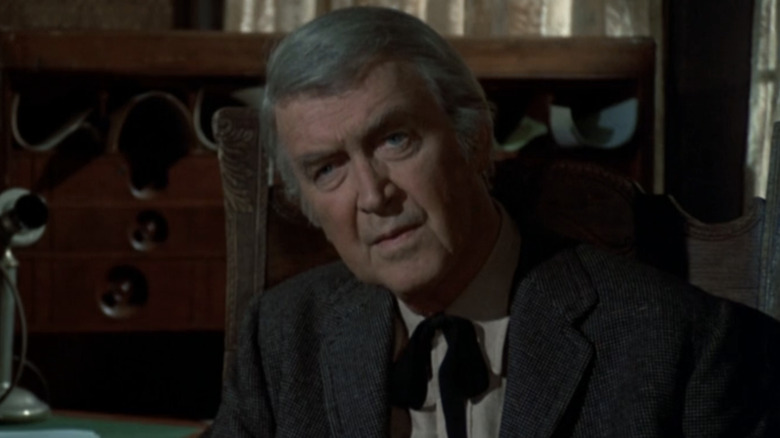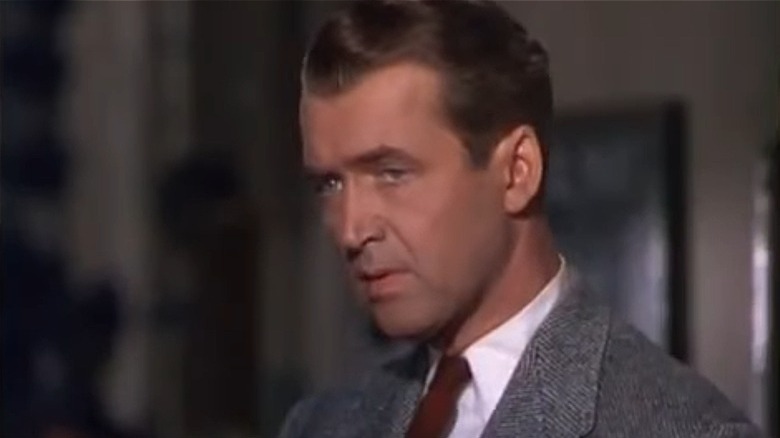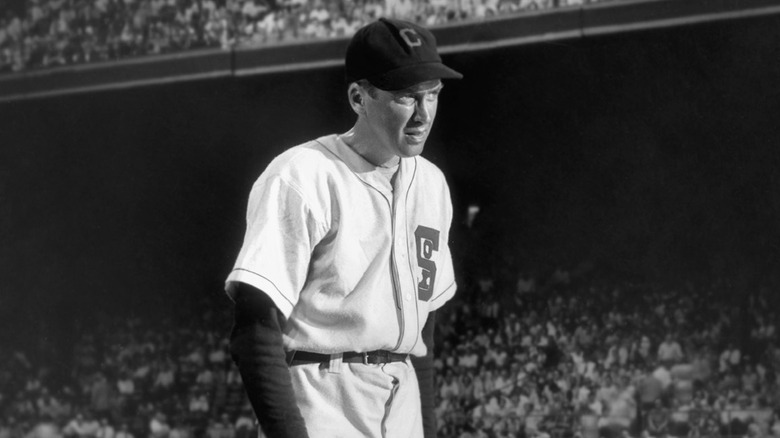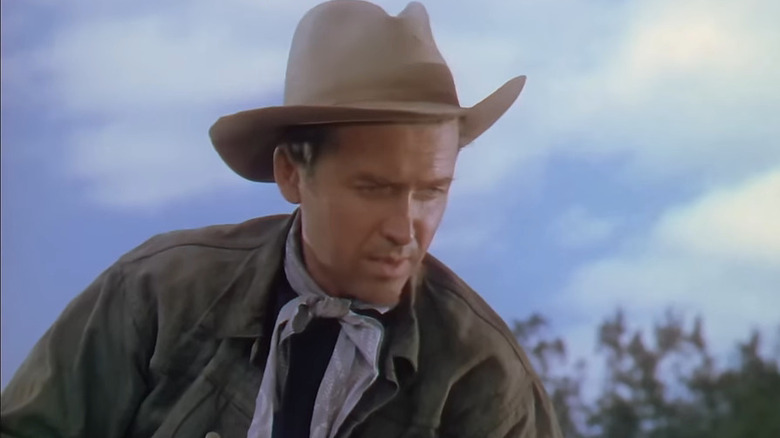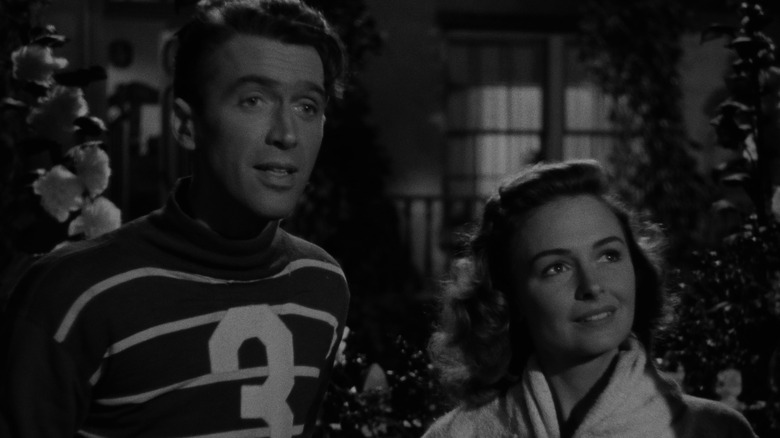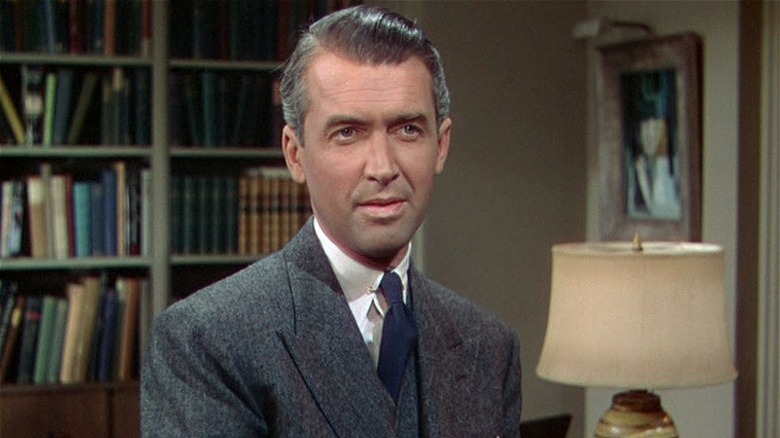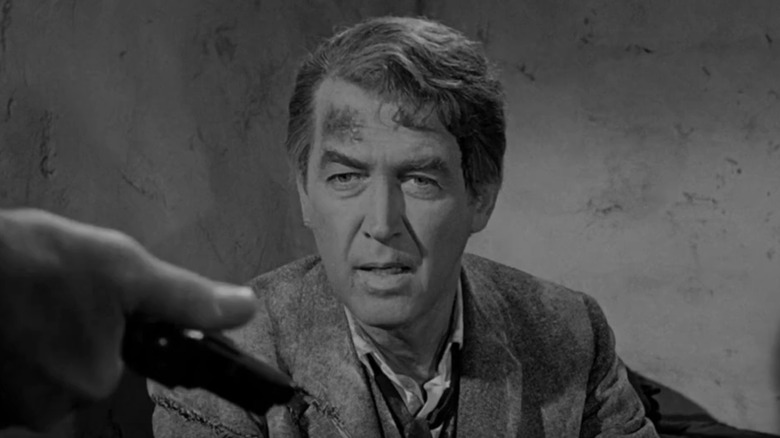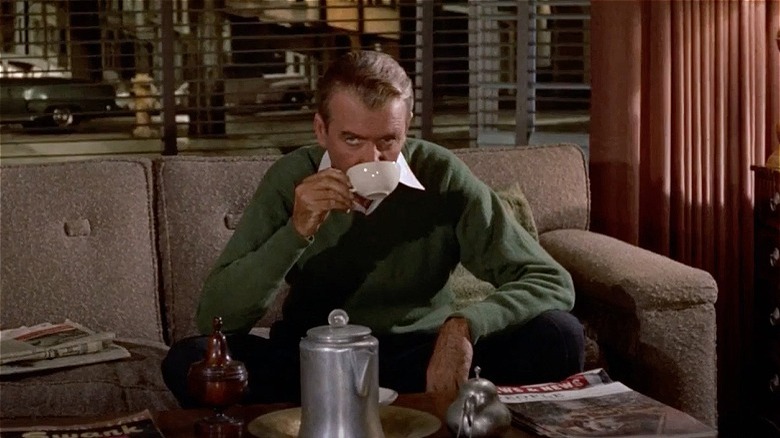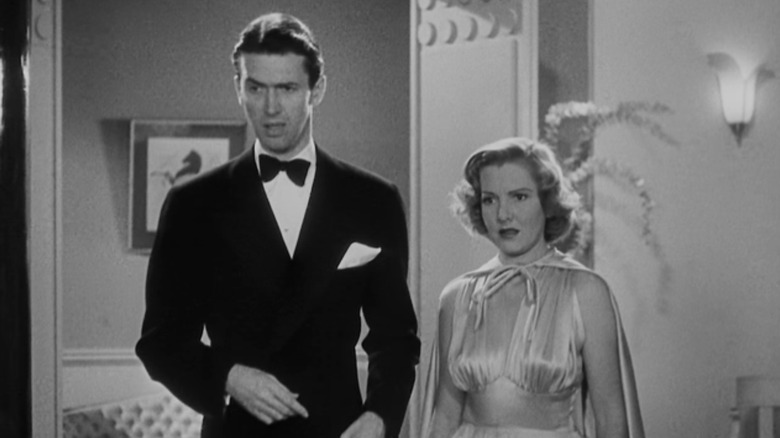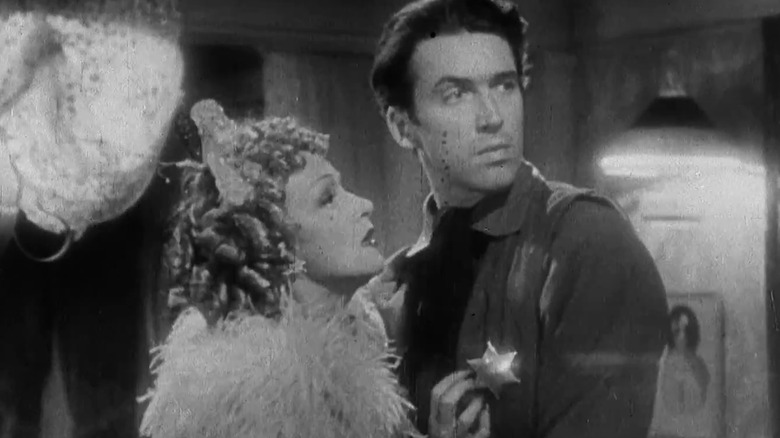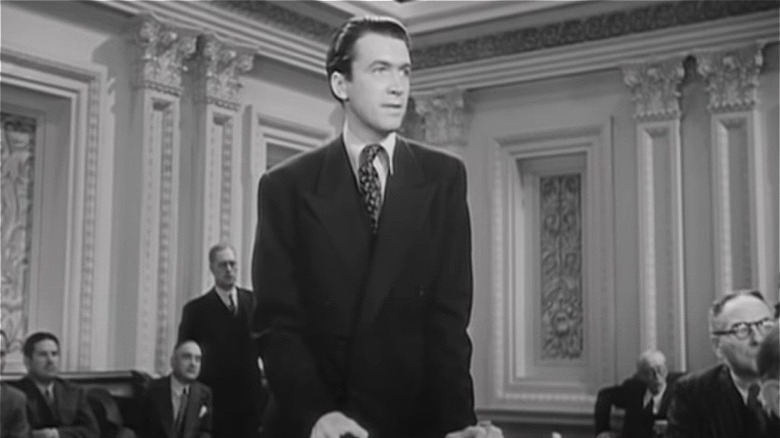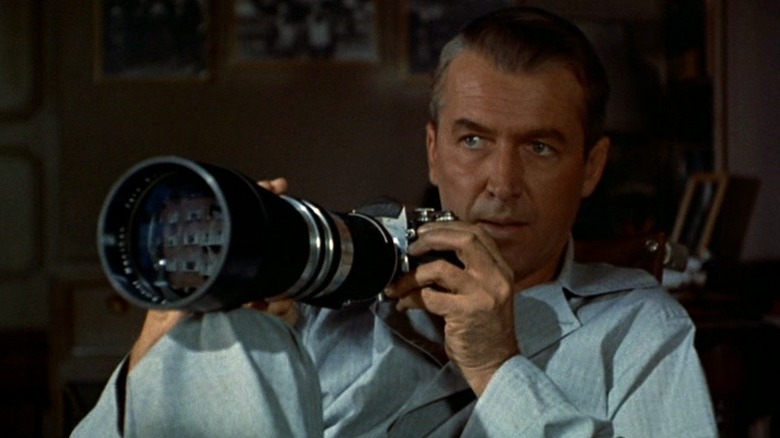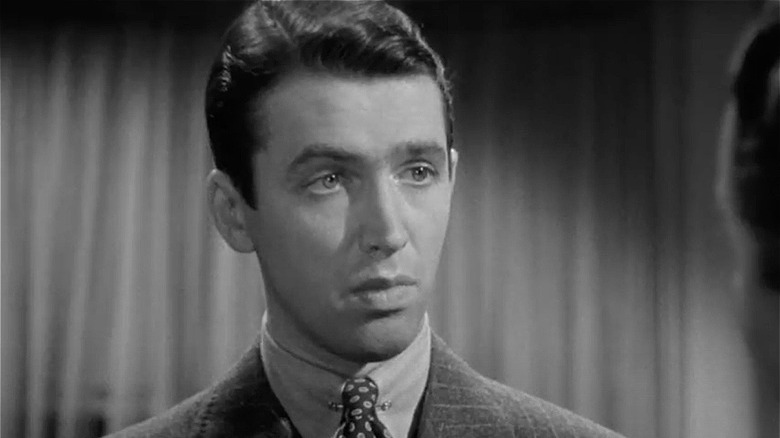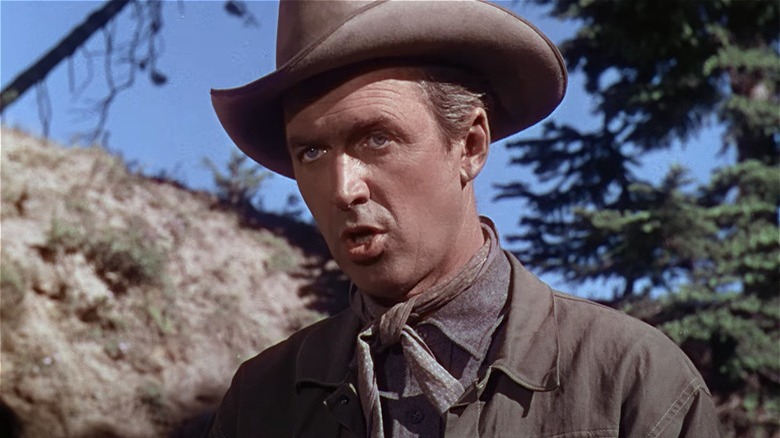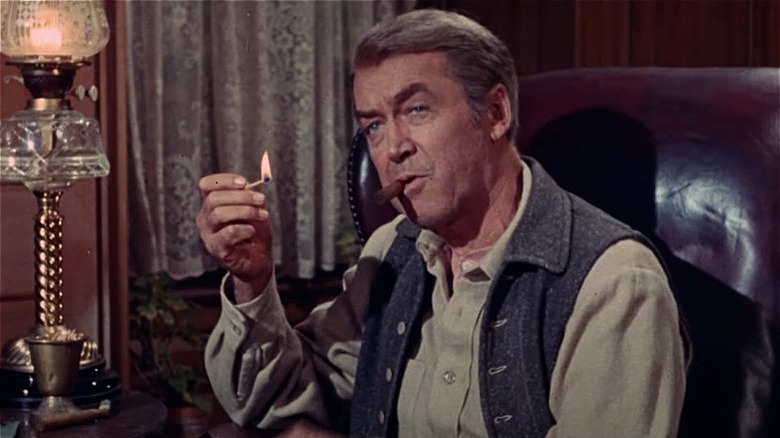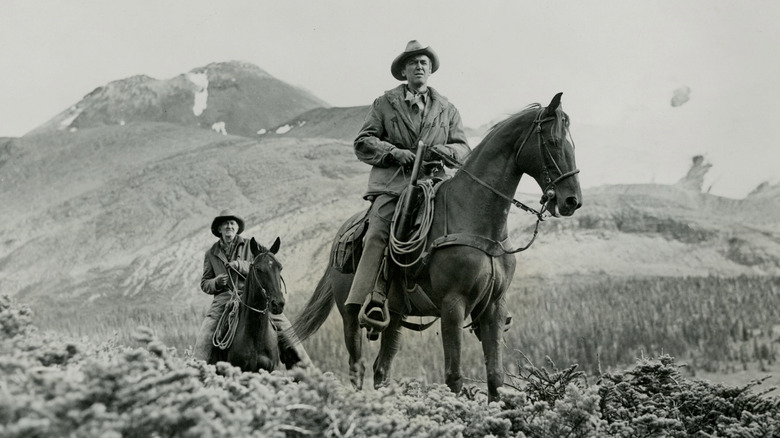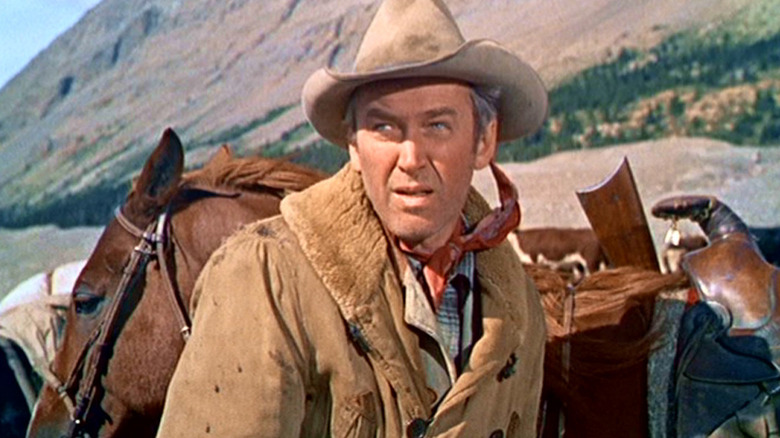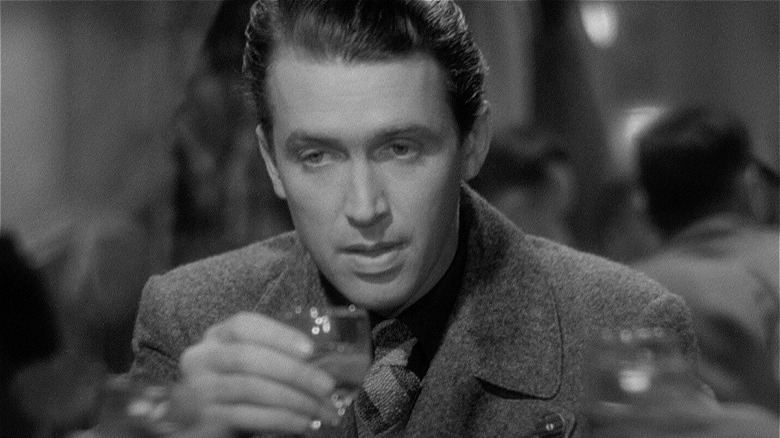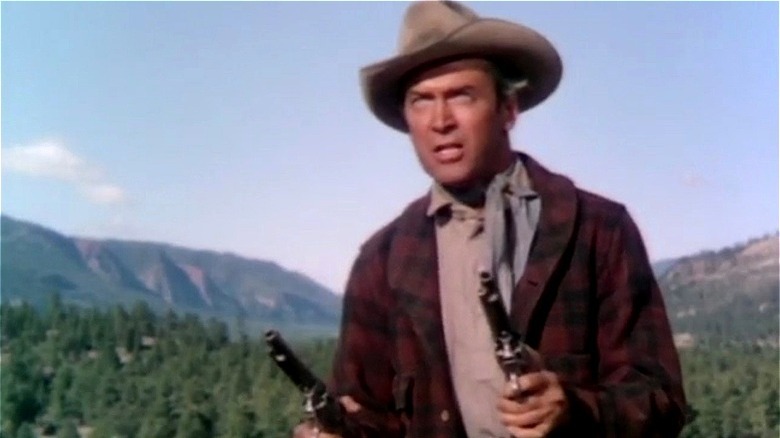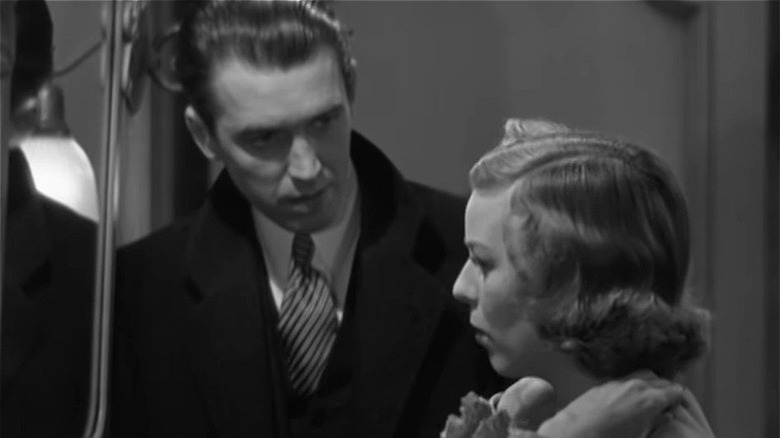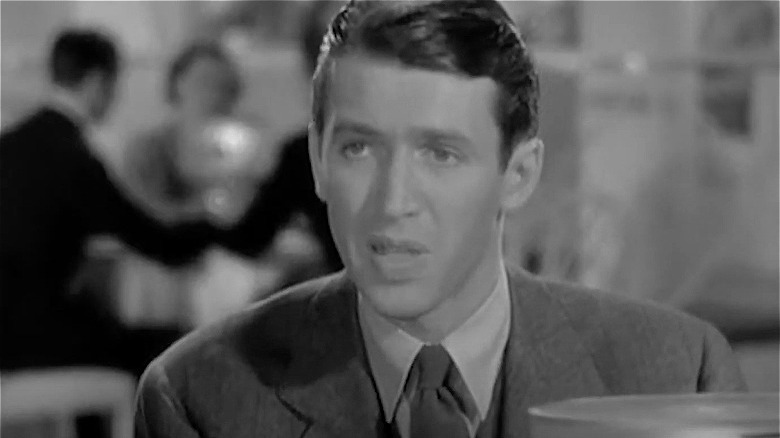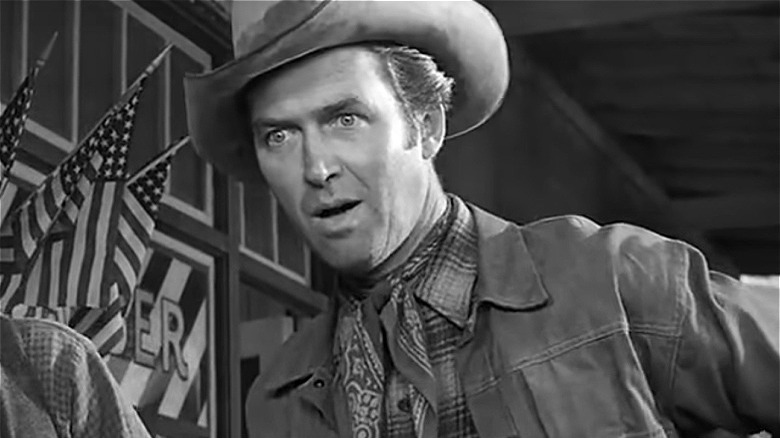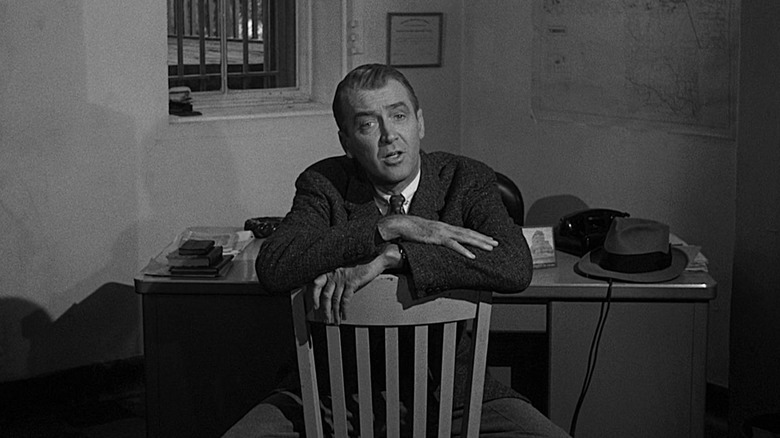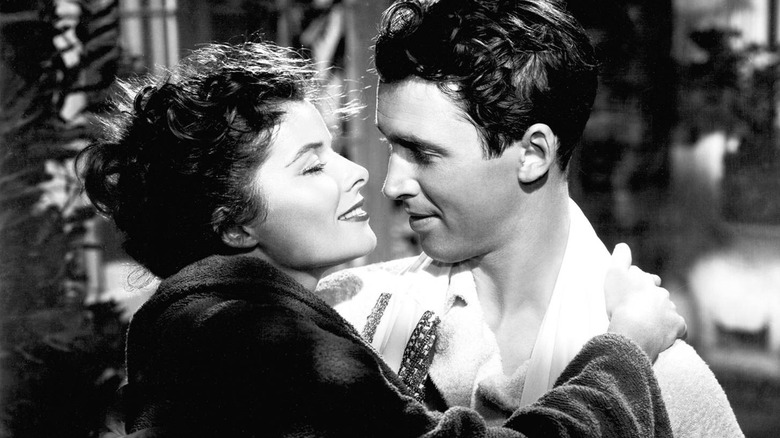65 Best James Stewart Movies Ranked Worst To Best
James Stewart — or Jimmy Stewart, to many of his fans — led a long and illustrious career that spanned six decades. Stewart got his start in the golden age of Hollywood in the 1930s and continued acting regularly into the 1970s before slowing down with semi-retirement in the '80s and giving a final voice-acting performance in 1991, just a few years before his death at the age of 89.
In his prime, James Stewart was one of Hollywood's biggest stars, with a unique voice and rhythm that set him apart from all of his contemporaries. He was often cast as the lovable leading man but played a handful of memorable supporting roles and anti-hero characters as well. From musicals to film noirs and everything in between, Stewart could do it all. His character was frequently a relatable everyman or a cowboy within the booming Western genre. He was also notable for his many performances as a member of the military, undoubtedly drawing on his distinguished career as an Air Force pilot during World War II, which earned him several medals and the rank of Brigadier General.
Beloved by critics and audiences alike, Stewart starred in many classic films over the years, ultimately receiving two BAFTA nominations, five Oscar nominations, and one Oscar win. In 1985, Stewart was awarded an honorary Oscar out of competition for "his fifty years of memorable performances" and for "his high ideals both on and off the screen." So when it comes to ranking his most memorable performances, have no fear: There's plenty of material to draw from.
65. Bandolero!
James Stewart's lowest-rated movie (according to Rotten Tomatoes) is "Bandolero!", one of the numerous Westerns that Stewart starred in throughout his life. At the height of his career, Westerns were an incredibly popular genre: The New York Times estimates that around 20% of all films from the classic Hollywood era were Westerns. But by the time "Bandolero!" arrived in 1968, Hollywood was changing and Westerns were shifting, struggling to avoid losing audience appeal due to the oversaturation of the genre.
Dean Martin stars as a bandit due to be hanged until his brother, played by Stewart, poses as the hangman and helps him escape. Two more big names of the time make up the rest of the main cast: Raquel Welch as a woman kidnapped by the outlaw brothers, and George Kennedy as the sheriff who attempts to hunt them down. The cast was a noted strength amongst critics, squandered on a weak script and production: Roger Ebert gave the film a negative review but still found room to praise Stewart's performance as a significant highlight.
64. On Our Merry Way
"On Our Merry Way" is a 1948 comedy that boasts a distinguished cast but failed to impress critics or audiences. Burgess Meredith stars as a lowly newspaper employee who cons his way into a higher position that finds him interviewing a cavalcade of wacky characters, but unfortunately, the loose plot often comes across as too episodic for its own good. James Stewart co-stars alongside Henry Fonda as a pair of musicians interviewed by the lead character, while Fred MacMurray as a magician, Paulette Goddard as the lead's wife, Dorothy Lamour as an actress, and others make up the rest of the cast.
In addition to starring in the film, Burgess Meredith also served as producer, which led the New York Times to suggest "On Our Merry Way" may have been something of a vanity project. This was his second time producing, following up "The Diary of a Chambermaid" in 1946. After the negative reception of "On Our Merry Way," Meredith never produced another feature film throughout the rest of his lengthy career as an actor.
63. The Rare Breed
"The Rare Breed" is another James Stewart Western from the late '60s, during a time when the genre was declining but not quite at the seismic shift that would follow in a couple of years. "The Rare Breed" was aimed at slightly younger audiences than many other Westerns and, as such, made use of a lighter tone. This choice unfortunately watered down the stakes and tension of the story as well, which was left feeling flat.
Stewart stars as a cowboy hired to transport bulls from Missouri to Texas with the goal of crossbreeding them for a wealthy widower, played by Maureen O'Hara. The main thrust of the story centers around a romance between Stewart and O'Hara, but their on-screen chemistry left a lot to be desired, and critics were not impressed by the movie. Dennis Schwartz called the film "banal and lifeless" and said that the storyline was "easily forgettable."
62. Airport '77
"Airport '77" is a thriller, made to capitalize on the disaster film trend that was massively popular at the time, and it was a follow-up to the earlier films "Airport" and "Airport '75." The first "Airport" film received positive reviews from critics, but the same could not be said of this disappointing sequel.
Just like the previous two films in the series, "Airport '77" is set aboard an in-flight airplane on which tragedy strikes. A private plane loaded with expensive artwork owned by a millionaire — played by James Stewart — is the setting this time around. After the plane is hijacked, it crashes and slowly sinks into the middle of the Bermuda Triangle, all while the people aboard the plane panic and search for a way to survive. The underwater setting could have made for a refreshing change of pace for the series, but audiences were left unconvinced.
Roger Ebert gave negative reviews to the entire "Airport" series and prompted readers with a challenge in his review for "Airport '77." Since he felt the plots were so silly and low-effort, he encouraged his readers to submit their own pitches for the next "Airport" sequel, with the winning entries being printed.
61. You Gotta Stay Happy
"You Gotta Stay Happy" doesn't have enough critic ratings on Rotten Tomatoes to form much of a consensus, but audience reviews have left the movie with a rotten score. James Stewart and Joan Fontaine star in this screwball comedy from 1948, where Fontaine plays a wealthy heiress with a history of abandoning fiancés right before the wedding. On the intended wedding night of her sixth fiancé, played by Willard Parker, she again flees the alter and instead invades the life of a pilot, played by Stewart, who at first wants nothing to do with her.
The two set off on a cross-country journey from New York to California and get into plenty of comedic misadventures along the way. Some of their hijinks involve a chimpanzee, which was a bit of a trend in Hollywood at the time, exemplified by Ronald Reagan acting alongside a chimpanzee just a couple of years later in "Bedtime for Bonzo."
60. Strategic Air Command
"Strategic Air Command" offered James Stewart a role that was perfectly tailored to his years of experience as a pilot in the Air Force. Stewart stars as a former WWII pilot who settles into a life as a professional baseball player before being called back to active service during the Cold War. His character's journey follows a similar trajectory to Stewart's own life, which found him returning to military service years after his stint in WWII to participate in the Vietnam War.
June Allyson also stars in "Strategic Air Command," as the wife of Stewart's character. The two had previously starred together in "The Glenn Miller Story," which was much more warmly received by critics and audiences alike. In a contemporary review published in Film Culture, Andrew George Sarris accused the film of serving as military propaganda in the vein of a recruitment poster and said that while the aerial photography of planes in flight was certainly impressive, the human drama on the ground was of a much lower caliber.
59. Magic Town
"Magic Town" is a 1947 comedy by director William A. Wellman. With four Oscar nominations and one win to his name, "Magic Town" is one of Wellman's lowest-rated movies. Wellman also directed the likes of "The Ox-Bow Incident," "Wings," and the original version of "A Star Is Born" from 1937, which has been remade three subsequent times.
James Stewart stars as a failed opinion-poll conductor whose career gets a second wind when he happens upon the town of Grandview, which serves as a perfect statistical representation of the entire United States. He uses this opinion microcosm to send his business soaring while also falling in love with a local. The concept is a bit obtuse and certainly sounds more than a little old-fashioned when viewed from a modern perspective. Critic Dennis Schwartz called the film "dated" and said that it "lacks an edge" but gave it an overall positive review regardless.
58. Night Passage
"Night Passage" is a Western from 1957 starring James Stewart and Audie Murphy as a pair of brothers on opposite sides of the law. Stewart and Murphy were familiar faces to the genre and both starred in many Westerns throughout their careers. Stewart plays a disgraced former railway worker who is given a second chance when he is hired as security aboard a payroll train loaded with cash. It's an especially dangerous job, as that particular payroll train has been robbed repeatedly for months. While performing his guard duties, he learns the unfortunate truth that his brother is one of the robbers and has earned a notorious reputation as a quickdraw outlaw.
During a time when some Westerns were still being released in black and white, "Night Passage" used its color presentation as a selling point and even made use of a brand new gimmick courtesy of the Technicolor company known as Technirama. This new camera format and presentation process was designed to create extremely wide images and retain a higher level of resolution, and was used primarily for epics such as "Spartacus," "Zulu," "Les Misérables," "The Big Country," and "El Cid." "Night Passage" was one of the first movies shot using the new Technirama format, but aside from this technical achievement, it otherwise fails to make much of an impact.
57. The Greatest Show on Earth
"The Greatest Show on Earth" divides film critics on Rotten Tomatoes right down the middle. The film was much better received around the time of its release and was a massive hit with general audiences, becoming the highest-grossing film of 1952 by a huge margin. It earned nearly triple the box-office revenue of the year's second-highest-grossing film, "The Snows of Kilimanjaro," and several times the gross of timeless classics like "High Noon," "Snow White and the Seven Dwarfs," and "Singin' in the Rain."
"The Greatest Show on Earth" is a drama set at a circus, exploring the lives of the various employees and performers. James Stewart plays Buttons, a clown with a troubled past. The rest of the cast is packed with some of the biggest stars of the day, including Charlton Heston, Cornel Wilde, Betty Hutton, and Dorothy Lamour, amongst others. "The Greatest Show on Earth" was the penultimate film of acclaimed director Cecil B. DeMille, who also directed the likes of "Cleopatra" and "The Ten Commandments." DeMille won the only Oscar of his career for best picture for "The Greatest Show on Earth."
56. Born to Dance
"Born to Dance" is a musical romantic comedy from 1936. James Stewart and Eleanor Powell star as a sailor and dancer who fall in love, but an unfortunate misperception leads to the release of photographs that make it look like the sailor is instead romantically involved with the dancer's top rival, played by Virginia Bruce. "Born to Dance" was directed by Roy Del Ruth, who made more than 100 movies throughout his career, many of which were musicals.
"Born to Dance" is a largely forgotten film, overshadowed by Stewart's more famous performances. But the handful of critics who have weighed in on the film, however, have been unanimously positive. In a contemporary review of the film published in 1937 in Maclean's Magazine, critic Ann Ross wrote that "Born to Dance is in the top flight of musical shows, the comedy is funnier than usual, the music better, the stepping faster."
55. Dear Brigitte
1965's "Dear Brigitte" is a comedy aimed at family audiences. James Stewart stars as a college professor with a passion for poetry and the arts, but a hatred of the more scientific subjects. His son, played by Bill Mumy, lands on the opposite end of the spectrum and is gifted in math while holding no talent or passion for artistic pursuits. The "Brigitte" of the title refers to Brigitte Bardot, the famous real-life French actor, model, and singer whom Bill Mumy's character has a fanboy crush on and plans to find after winning money for a flight to Paris betting at the racetrack.
Brigitte Bardot appears in the film as herself, and other notable names in the cast include the likes of Cindy Carol, Glynis Johns, John Williams, and Fabian. The story of "Dear Brigitte" was adapted from the novel "Erasmus With Freckles" written by John Haase. The film adaptation was directed by Henry Koster, who was also responsible for "The Bishop's Wife," "My Man Godfrey," and "Harvey," the latter of which will pop up later on this list.
54. No Time for Comedy
The deceptively titled "No Time for Comedy" is a comedy from 1940 starring the big-name duo of James Stewart and Rosalind Russell. Stewart plays a humble writer who finds success by writing a satirical play and ends up falling for the show's lead, played by Russell. The two get married and enjoy a string of successes until the seductive Amanda Swift, played by Genevieve Tobin, drives a wedge between them and sends the writer's career into a tailspin.
The story was adapted from a stage play written by S.N. Behrman, first produced just one year before the film adaptation. Behrman began his career as a journalist before finding a great deal of success as a playwright, just like the main character of "No Time for Comedy." The play was based largely on his own experiences writing for the stage, as he balanced his proclivity for comedy with the seriousness of the issues of the day.
53. Carbine Williams
"Carbine Williams" is a biopic from 1952 that tells the true story of David Marshall Williams. James Stewart stars as Williams, who begins the film as a moonshiner before being sent to prison. After serving a portion of his sentence, the prison warden takes a liking to Williams and gives him the opportunity to put his talents to use in the prison's workshop. While incarcerated, Williams invents the dominant rifle used by U.S. soldiers during World War II, the M1 Carbine, which earned him the nickname Carbine Williams.
This story of a criminal leaving behind a somewhat heroic legacy was seen as uplifting and inspirational by some viewers, while others found it boring and lacking in drama. "Carbine Williams" was directed by Richard Thorpe, who began his career as an actor in the 1920s before quickly pivoting to directing — he would rack up a staggering 187 directorial credits in the span of just 44 years. Thorpe had a reputation for shooting extremely quickly with as few takes as possible, which often led to bland direction seemingly devoid of style.
52. Of Human Hearts
1938's "Of Human Hearts" is a drama set in the 1800s, one of James Stewart's few non-Western period pieces. Walter Huston and Beulah Bondi play a reverend and his wife, while Stewart plays their rebellious son who aspires to be a doctor despite his parents' wishes. Stewart's character finds his abilities put to great use as a battlefield surgeon after the outbreak of the Civil War. Despite his commendable efforts to treat wounded soldiers, Stewart's character possesses many undesirable qualities and is, to a certain degree, the antagonist of the film, especially in regard to how he treats his parents.
Beulah Bondi received an Oscar nomination for her role. In addition to portraying Stewart's on-screen mother in "Of Human Hearts," she also played his mother in "Mr. Smith Goes to Washington," "Vivacious Lady," "It's a Wonderful Life," and the television series "The Jimmy Stewart Show." Also of note in the cast of "Of Human Hearts" are Gene Lockhart, Arthur Aylesworth, Sterling Holloway, and David Carradine (father of actors David, Keith, and Robert Carradine) as Abraham Lincoln.
51. Pot o' Gold
"Pot o' Gold," also known as "The Golden Hour," is the second James Stewart musical on the list and one of two musicals he headlined in 1941, alongside "Ziegfeld Girl," which lands much higher in this ranking. The story is a straightforward romance between Stewart and Paulette Goddard with the backdrop of a feud between Stewart's music-hating uncle and Goddard's theatrical family. The other big draw for the film is Horace Heidt playing a fictionalized version of himself — Heidt was a famous big-band leader and the host of a popular radio program, which was also titled "Pot o' Gold."
The film was not well-received at the time, and Stewart was vocal about his dislike for the film. Stewart would eventually call "Pot o' Gold" his worst movie. Some critics found an appreciation for "Pot o' Gold," but others agreed with Stewart that the film was the lowlight of his career. Critic Dennis Schwartz called the movie a "nonsensical fluff piece" that "never elicits anything funny or worthwhile."
50. Firecreek
"Firecreek," also known as "Fury at Firecreek," is another James Stewart Western from the late '60s. The setting of a small, poor town on the frontier and the premise of a kindly sheriff needing to defend his home from a gang of outlaws are both extremely familiar within the genre. In fact, the film's failure to set itself apart from the myriad other Westerns of the time is likely responsible for "Firecreek" being overlooked. It was a financial failure, earning back less than half of its production budget at the domestic box office.
Rather than offering a unique story, the main draw for "Firecreek" was its two lead stars — James Stewart and Henry Fonda — and, more specifically, how those stars were utilized. Stewart plays comfortably within his archetype but unleashes a seldom-seen fury in the film's latter half. Roger Ebert gave the film a positive review and compared Stewart favorably to the era's biggest Western star, John Wayne. "Wayne hath no fury like a Stewart scorned," he wrote in his review.
Fonda made an even bigger departure from his usual screen persona and marked a major shift in his career by taking on the role of the film's main villain. Prior to "Firecreek," Fonda had only played admirable good guys. In the same year, Fonda also played the villain in Sergio Leone's spaghetti western "Once Upon a Time in the West."
49. Made for Each Other
"Made for Each Other" is a romantic comedy from 1939 that lays the drama on thick. James Stewart stars as a lawyer who falls in love at first sight with Carole Lombard's character. The two enjoy a whirlwind romance and get married within a single day of meeting each other. The good times don't last long, though, as troubles strike the newlywed couple, financial and otherwise. Complicating the matter, they soon have a baby on the way, and Stewart's character is passed over for an expected promotion by his cantankerous boss (Charles Coburn), who holds a grudge against Stewart for getting married to this other woman instead of his daughter (Ruth Weston).
Some of the criticism toward "Made for Each Other" was directed at the extent of the drama befalling the two lead characters, which occasionally stretches the bounds of plausibility and clashes with the lighter comedic elements. Many critics accused the film of verging into soap opera territory, for better or worse. Critic Dennis Schwartz called the film a "dated and absurd soap opera" but gave the film a positive review regardless, writing that it "still works mainly because of the good chemistry between ... James Stewart and Carole Lombard."
48. The Big Sleep
"The Big Sleep" is a 1978 adaptation of the Raymond Chandler novel of the same name. Chandler is often hailed as a master of the noir genre, and "The Big Sleep" was his first novel, published in 1939. The novel was also the introduction of one of the noir genre's defining characters: Private Eye Philip Marlowe. Marlowe would serve as the protagonist of ten of Chandler's novels and short stories, and would be played on the big screen by such actors as Humphrey Bogart, Elliot Gould, Powers Boothe, James Caan, Michael Gambon, James Garner, and, in the case of the 1978 adaptation of "The Big Sleep," by Robert Mitchum.
James Stewart costars as General Sternwood, the elderly man who hires Marlowe to investigate a complicated blackmail plot involving his daughters, gangsters, a missing husband, and professional assassins. This second adaptation of the classic noir story — directed by Michael Winner of "Death Wish" fame — updated the setting to the contemporary 1970s, swapped Los Angeles for London, and attempted to smooth over a couple of plot holes present in the previous version, but was considered by most critics to be an inferior film.
47. The Last Gangster
"The Last Gangster" stars Edward G. Robinson as a violent gangster who gets sent to prison for tax evasion, leaving his young wife, played by Rose Stradner, to give birth and raise their child on her own. James Stewart co-stars as a reporter who exposes the violent side of Robinson's character to his wife while he's locked away. Stewart and Stradner wind up getting married, leading to Robinson seeking revenge after his eventual release from prison several years later.
The film was directed by Russian filmmaker Edward Ludwig, who directed over 100 movies and television shows throughout his 46-year career. The screenplay for "The Last Gangster" came courtesy of John Lee Mahin, who was Oscar-nominated for "Captain Courageous" and "Heaven Knows, Mr. Allison," and also worked on the screenplays for classics like "Treasure Island," "The Wizard of Oz," "A Star is Born," "Dr. Jekyll and Mr. Hyde," and the original "Scarface."
46. Cheyenne Autumn
Here, we encounter yet another middling Western starring James Stewart. "Cheyenne Autumn" is a Western epic from the iconic director John Ford, who created dozens of highly acclaimed films throughout his career including "The Grapes of Wrath," "Stagecoach," and some of the best-remembered and well-liked Westerns on Stewart's filmography. It would be Ford's last Western, and although it received an Oscar nomination for cinematography, it was not a financial success.
The story of "Cheyenne Autumn" follows the Cheyenne tribe as they make a 1,500-mile trek back to their ancestral grounds after suffering many injustices at the hands of the U.S. Government. Richard Widmark stars as a cavalry officer ordered to prevent their journey and force them back onto their reservation land. The large cast also includes the likes of Edward G. Robinson, John Carradine, Sal Mineo, Karl Malden, Carroll Baker, Gilbert Roland, and many more. James Stewart and Arthur Kennedy play off each other as the real-life western legends Wyatt Earp and Doc Holliday respectively.
45. The FBI Story
1959's "The FBI Story" is a blending of fact and fiction that attempts to explore the history of the Federal Bureau of Investigation by tracking the decorated career of one particular FBI Agent, Chip Hardesty, played by James Stewart. The film covers a long period of time and makes use of a somewhat episodic structure in order to cover many of the FBI's biggest targets from gangsters to Cold War spies to the KKK. Co-starring as Chip's wife is Vera Miles, and the cast also includes Murray Hamilton, Larry Pennell, Jean Willes, and Nick Adams.
The story is an adaptation of the non-fiction book "The FBI Story: A Report to the People" written by multiple Pulitzer Prize-winning journalist Don Whitehead. "The FBI Story" is a noteworthy film in that it included the participation of J. Edgar Hoover playing himself. Hoover became the director of the Bureau of Investigation (before "Federal" was added to the name) in 1924 and was still serving as the active director when he appeared in "The FBI Story." This film remained his only on-screen appearance in a motion picture.
44. The Jackpot
"The Jackpot" is a high-concept comedy from 1950. James Stewart plays a normal family man who wins the jackpot of a call-in radio trivia show, but his newfound riches make his life worse instead of better. The $24,000 jackpot is comprised of myriad prizes that prove to be a nightmare to manage and maintain, and the winnings require him to pay an exorbitant amount in taxes that he cannot afford.
The film was adapted from an article originally published in The New Yorker one year prior. Penning the screenplay for the adaptation was the husband and wife screenwriting duo of Henry and Phoebe Ephron. Henry and Phoebe were the parents of Delia and Nora Ephron, both of whom became the acclaimed screenwriters of movies like "When Harry Met Sally," "Sleepless in Seattle," "You've Got Mail," and "Julie & Julia." In the director's chair for "The Jackpot" was Walter Lang, the Oscar-nominated filmmaker behind "The King and I," "Cheaper by the Dozen," and "Call Me Madam."
43. Fools' Parade
"Fools' Parade" is a comedic thriller from 1971, set in 1930s West Virginia. James Stewart stars as Mattie Appleyard, a convict with a glass eye who is released from prison after 40 years of incarnation. Along with two of his reformed prison mates, played by Kurt Russell and Strother Martin, Appleyard tries to go straight and open up a store. Standing in their way are a corrupt prison guard and banker, played by George Kennedy and David Huddleston, respectively. The antagonistic duo swindle Appleyard out of his savings earned while in prison and put a halt to the recently released convicts' plans.
The story was adapted from the novel of the same name written by Davis Grubb. Stewart's performance in the lead role was greatly acclaimed, even by critics who found that the overall film left a lot to be desired. Critic Tony Mastroianni gave the film a negative review, but commended Stewart's efforts, writing, "It is the kind of picture that leans heavily on Stewart's skill, personality and built-in folksiness. Time and again he gives you the impression of an interesting character that really isn't there in the role."
42. The Magic of Lassie
"The Magic of Lassie" was the final true live-action movie of James Stewart's career to receive a theatrical release. It was the ninth movie in the long-running "Lassie" film franchise that began all the way back in 1943 with "Lassie Come Home," which was adapted from the novel of the same name written by Eric Knight. The story follows a similar plot to other "Lassie" movies involving the titular dog making her way home to her young owner. In this iteration, Stewart plays the boy's grandfather.
The box-office failure of "The Magic of Lassie" was at least partially responsible for the end of Stewart's acting character. As covered in Deadline, "James Stewart decided to retire from acting in 1978 at age 70 when The Magic of Lassie flopped," and he was quoted as saying, "I can't even open a dog movie." Technically, Stewart did appear in one additional feature film in 1981, the extremely obscure "A Tale of Africa," although his role in the film is purely serendipitous. Supposedly, Stewart just happened to be on a family vacation in Kenya after retiring from acting when co-directors Simon Trevor and Susumu Hani stumbled upon him and convinced him to appear in the movie.
41. Thunder Bay
The 1953 drama "Thunder Bay" is set in 1946 and follows a former Navy engineer, played by James Stewart, who relocates to Louisiana with plans to establish an offshore oil drilling platform, but faces major pushback from the locals and is forced to deal with the natural effects of a devastating hurricane as well. Dan Duryea, Gilbert Roland, Joanne Dru, Antonio Moreno, Marcia Henderson, and Jay C. Flippen co-star.
"Thunder Bay" was embroiled in an unusual sort of controversy in regards to its aspect ratio upon release. The film was shot in the 1.37-1 aspect ratio, which had been considered the standard of the time. However, Universal Pictures sought to capitalize on the potential audience draw of the exciting new widescreen formats and decided to pretend that "Thunder Bay" was shot in the 1.85-1 aspect ratio instead. Faking this aspect ratio change meant stretching out the original frame, which was more of a square shape, by chopping off the top and bottom of the frame and projecting the remaining image on a wider screen. Aside from the controversy, "Thunder Bay" is a decent if forgettable drama.
40. No Highway in the Sky
"No Highway in the Sky" is a British thriller from 1951. James Stewart stars as an American engineer who becomes convinced that metal fatigue will cause a new model of aircraft to malfunction and fail in mid-air after reaching a certain number of flight hours. He attempts to convince the manufacturer to do a recall of the aircraft before disaster strikes, but nobody believes him. Matters are exacerbated when Stewart's character finds himself aboard one of the planes as it nears the number of flight hours he has determined will result in mechanical failure. By taking drastic action and refusing to back down, Stewart's character earns the respect of some while doubters begin to question his mental faculties.
The story was loosely based on the novel "No Highway" written by Nevil Shute, but it was changed considerably in translation onto the big screen. The most significant alteration was in regards to realism. The novel employs some supernatural elements, while the film adaptation stripped those elements away and presented the story as wholly realistic. "No Highway in the Sky" was the second collaboration between Stewart and director Henry Koster after "Dear Brigitte."
39. Take Her, She's Mine
Director Henry Koster returns to the list with "Take Her, She's Mine." This 1963 comedy stars James Stewart and Sandra Dee as father and daughter. When she leaves for college, Stewart's character follows her all the way to art school in Paris in the hopes of keeping her sheltered, but scandal after scandal follows — ultimately leaving him in trouble with the board of education, who ask for his resignation as their president. The film contains a memorable and quirky meta subplot involving a character within the film mistaking Stewart's character for the famous Hollywood actor James Stewart.
The film was adapted from the stage play of the same name, which was first performed on Broadway in 1961. The play was written by Henry and Phoebe Ephron, who also wrote the script for Stewart's "The Jackpot." The Ephrons based the story on their worries about their own daughters, Nora and Delia, heading off to college.
38. The Cheyenne Social Club
"The Cheyenne Social Club" is a western comedy from 1970 that makes use of James Stewart's advanced age as a part of the plot. The story follows Stewart's old cowboy character as he relocates to Cheyenne, Wyoming after he is unexpectedly bequeathed a business following the death of his estranged brother. The title, "The Cheyenne Social Club," is the name of the business, which the cowboy is dismayed to learn is a brothel. Before he can sell the establishment, he gets caught up in the middle of a violent altercation between a customer and the madam, which has a ripple effect that ensures more danger will be forthcoming.
Co-starring alongside Stewart was Henry Fonda. Stewart and Fonda were close friends in real life, having begun their careers in Hollywood at the same time and collaborating a number of times on-screen. A non-fiction book was even written about their friendship titled "Hank & Jim: The Fifty-Year Friendship of Henry Fonda and James Stewart." After Henry Fonda's death in 1982, James Stewart's public statement on the matter was: "I've just lost my best friend."
"The Cheyenne Social Club" found Stewart and Fonda under the direction of another fellow actor: Gene Kelly, the star of movies like "Singin' in the Rain," "Anchors Aweigh," "An American in Paris," and "Hello, Dolly!" This was Kelly's final feature film in the director's chair.
37. Come Live with Me
1941's "Come Live with Me" is a romantic comedy exploring the foibles of a love square between a refugee seeking U.S. citizenship, a publisher, the publisher's wife, and an author. These four leads are played by the team of Hedy Lamarr, Ian Hunter, Verree Teasdale, and James Stewart, respectively. Lemarr and Stewart play the central romantic coupling, wedding first as a transactional marriage in which Lemarr's character ensures her citizenship and pays Stewart's character a weekly salary in exchange, only to have a real romance blossom in time.
"Come Live with Me" was directed by Clarence Brown, who was nominated for the best director Academy Award an astonishing six times between 1930 and 1947. Two of his nominations even arrived in the same year, with "Anna Christie" and "Romance" both released in 1930. Stewart and Hedy Lemarr would also star opposite each other that same year in the musical "Ziegfeld Girl."
36. Bell Book and Candle
"Bell Book and Candle" is a romantic comedy from 1958 with a supernatural twist. Kim Novak stars as a witch who sets her sights on a publisher, played by James Stewart. Through the use of magic, she makes him leave his fiancée, played by Janice Rule, and fall in love with her instead. Ernie Kovacs and Jack Lemmon play major supporting roles as an author writing a book about witchcraft and the warlock brother of Novak's witch character, respectively. By the internal logic of the movie, falling in love with Stewart's character could result in the witch losing her powers, so she faces a dilemma as their relationship escalates.
The story of "Bell Book and Candle" was adapted from the stage play of the same name, which opened on Broadway in 1950. It was written by John Van Druten, who wrote dozens of successful plays throughout his career, many of which were eventually adapted for the silver screen. Penning the adapted screenplay for "Bell Book and Candle" was Daniel Taradash, the Oscar-winning screenwriter behind "From Here to Eternity."
35. It's a Wonderful World
"It's a Wonderful World" is a screwball comedy with a crime plot about an innocent man, played by Ernest Truex, who is falsely accused of murder. James Stewart stars as the private detective hired to get him out of trouble and catch the real murderer, but the police apprehend both of them before he can solve the crime. The P.I. slips away from the police and goes on the run while attempting to solve the crime. Claudette Colbert co-stars as a poet who gets kidnapped by the P.I., and a romance slowly blooms between the two despite their differences.
The title of "It's a Wonderful World" probably calls to mind "It's a Wonderful Life." Despite the similar titles and the fact that both films star James Stewart, the two movies have nothing to do with each other, and "It's a Wonderful World" was released seven years earlier in 1939. "It's a Wonderful World" might not have achieved the same classic status enjoyed by "It's a Wonderful Life," but it is a solid film in its own right.
34. Ziegfeld Girl
"Ziegfeld Girl" is a 1941 musical set two decades earlier amidst the Roaring '20s. The title is a reference to the "Ziegfeld Follies," a massively popular Broadway musical show that first debuted in 1907. The real-life "Ziegfeld Follies" is used as the backdrop for this fictional story. The plot follows three young women, played by the high-profile trio of Hedy Lamarr, Lana Turner, and Judy Garland, as they get their big break by being cast as dancers in the latest production of the show. But as their careers are on the way up, their personal lives begin to suffer.
James Stewart stars as the male lead opposite the trio of women, and the film makes use of supporting turns from the likes of Jackie Cooper, Ian Hunter, and Tony Martin. The musical numbers for "Ziegfeld Girl" were handled by Busby Berkeley, one of the most innovative voices of the musical genre in the golden age of Hollywood. Berkeley directed and choreographed dozens of big screen musicals throughout his long career, often making multiple films per year.
33. Call Northside 777
"Call Northside 777" is a film noir released in 1948, right in the middle of the classic noir era. After a man spends 11 years in jail, his mother, played by Kasia Orzazewski, makes one last-ditch effort to clear his name. James Stewart stars as the Chicago reporter tasked with re-investigating the murder case that was considered solved more than a decade prior. Lee J. Cobb plays a major supporting role as the editor of the paper that Stewart works for.
The story of "Call Northside 777" was based in part on a true story. Articles written by Jack McPhaul and James P. McGuire laid the foundation for the story. Stewart's character, PJ McNeal, is based in part on the real journalist, JP. McGuire, as evidenced by the similarity of the names. In a contemporary review for the film published in 1948, Time Magazine wrote that Stewart's performance was up to par with his best work and praised the film's sound design, saying that it deserved a special achievement Oscar.
32. Mr. Hobbs Takes a Vacation
"Mr. Hobbs Takes a Vacation" is a family-friendly comedy from 1962. James Stewart stars as the titular Mr. Hobbs who (you guessed it) takes a vacation. The straightforward plot follows Mr. Hobbs, his wife played by Maureen O'Hara (who would star alongside Stewart again four years later in "The Rare Breed"), and their children as they deal with the simple misadventures of a family beach vacation that doesn't quite go as planned.
Also of note in the cast are John McGiver, Reginald Gardiner, John Saxon, and the musician Fabian, who would act opposite James Stewart again in 1965 in "Dear Brigitte" made by the same director, Henry Koster. In a contemporary review published in The New York Times at the time of the film's release in 1962, film critic Bosley Crowther called the film a mixed bag that came off as an overall positive experience.
31. Rose-Marie
"Rose-Marie" provided James Stewart with one of his first-ever screen performances — released in 1936, it's the oldest movie on this list. The film is a musical set in Canada starring the romantic pairing of Nelson Eddy and Jeanette MacDonald. James Stewart had not yet risen to the status of "leading man," but he plays the standout supporting role. MacDonald plays an opera singer who sets out to help her escaped-convict brother, played by Stewart. Eddy plays a Mountie officer on the hunt for the escaped prisoner, unaware that he is falling in love with his target's sister.
The story of "Rose-Marie" was adapted from the stage play of the same name first produced as early as 1924. The play was written by the team of Otto Harbach and Oscar Hammerstein II, the latter of whom is one-half of the highly acclaimed Broadway musical duo, Rodgers & Hammerstein. Together, Richard Rodgers and Oscar Hammerstein II created the timeless plays "Oklahoma!," "The King and I," and "The Sound of Music." Hammerstein II wrote the book and lyrics for "Rose-Marie" nearly two decades before the formation of the Rodgers & Hammerstein duo.
30. Two Rode Together
"Two Rode Together" is the second James Stewart Western on the list directed by acclaimed filmmaker John Ford. In a rare anti-hero role, Stewart plays a corrupt, alcoholic Texas Marshall who is hired by a man from the U.S. Army, played by Richard Widmark, to rescue a group of people who have spent years in captivity at the hands of a Comanche tribe. The two are able to negotiate the release of the captives, but they have been gone so long that they retain little memory of their earlier lives and struggle to reacclimate to their former society.
"Two Rode Together" earned a spot on the top 10 movies of 1961 list in the Cahiers du Cinema, the prestigious French publication run by the country's top critics, many of whom were highly acclaimed filmmakers in their own right, including François Truffaut, Éric Rohmer, and Jean-Luc Godard.
29. Harvey
"Harvey" provided James Stewart with one of his most iconic roles and earned him his fourth Academy Award nomination for best actor in a leading role. Though Stewart lost out to José Ferrer, his co-star Josephine Hull won for her supporting performance in "Harvey." This enduring classic tells the story of a jovial if eccentric man named Elwood, who breezes through life with the help of his best friend Harvey. The only problem is that Harvey is a six-foot tall anthropomorphic rabbit, and he is invisible to everyone other than Elwood. Those around Elwood believe him to be insane and attempt to get him committed to a mental hospital.
This funny and heartwarming dramedy started out as a stage play first produced in 1944 before being adapted for the big screen. The stage play of "Harvey" was written by Mary Chase, who won the Pulitzer Prize in drama for her efforts. More than two decades later, Stewart went on to reprise his role as Elwood in a 1972 made-for-TV color remake of "Harvey."
28. How the West Was Won
"How the West Was Won" is the penultimate collaboration between star James Stewart and director John Ford. What sets this film apart is that Ford was not the only director at the helm: There were actually four filmmakers directing different parts of the movie. "How the West Was Won" tells the sprawling saga of a frontier family that progresses through multiple decades and key moments in the history of the West from the Gold Rush to the Civil War.
The film is divided into five segments plus an epilogue, and John Ford, Henry Hathaway, and George Marshall shared the directing duties of individual segments, with Richard Thorpe lending an uncredited hand as well. The big selling point for "How the West Was Won" was its massive cast of big-name stars. Alongside Stewart in a lead role were the likes of Henry Fonda, John Wayne, Gregory Peck, Karl Malden, Lee J. Cobb, George Peppard, Debbie Reynolds, Eli Wallach, Richard Widmark, Carroll Baker, and many more.
27. The Flight of the Phoenix
"The Flight of the Phoenix" is an adventure film from 1965 in the vein of the disaster genre, which would rise to major prominence a few years later and become known for bringing together large casts of A-list actors. In some ways, "The Flight of the Phoenix" feels like a trial run for the genre. It was a bit of a box office failure — only earning back $3 million of its over $5 million budget — despite a great deal of star power.
The story explores the life-or-death scenario of a small group of men aboard a cargo plane that crashes in the Sahara desert. Their best and only plan for survival comes from an airplane designer, who believes they can construct a working aircraft out of the wreckage of the cargo plane. But the task is daunting, and they have a limited supply of food and water to get the job done. James Stewart, Peter Finch, Richard Attenborough, Ernest Borgnine, Dan Duryea, and George Kennedy make up the high-profile cast of survivors.
The production of "The Flight of the Phoenix" was sadly marred with tragedy. During the shooting of an airplane stunt, stuntman Paul Mantz was killed, and a second stuntman was severely injured.
26. The Spirit of St. Louis
"The Spirit of St. Louis" tells the true story of pioneering aircraft designer and pilot Charles Lindbergh, played on screen by James Stewart. The film tracks the lengthy period of his life that revolved around aviation with a special focus on his groundbreaking 1927 transatlantic flight from New York to Paris. The film was adapted from Lindbergh's own autobiography, for which Lindbergh won the Pulitzer Prize.
Acclaimed screenwriter and filmmaker Billy Wilder directed and co-wrote the big-screen adaptation of "The Spirit of St. Louis." Wilder was the man behind classics like "Sunset Blvd," "The Apartment," "Some Like it Hot," "Sabrina," and many more. He won six Academy Awards throughout his career plus an extra honorary award, and was nominated an additional 15 times for Oscars in the writing and directing categories. "The Spirit of St. Louis" was well-received by critics, with special praise being given to Stewart in the lead role, who spends most of the film putting on a captivating one-man show. If there is one major criticism to be leveled at "The Spirit of St. Louis," it is for its sanitized portrayal of Lindbergh. The film presents Lindbergh as a heroic patriot who can do no wrong, while in reality, he was a supporter of Hitler's party and an outspoken white supremacist.
25. The Man Who Knew Too Much
The master of suspense, Alfred Hitchcock, first directed "The Man Who Knew Too Much" in 1934, with Peter Lorre in one of his first English-language performances. 22 years later, Hitchcock remade his own movie, now in color and with James Stewart and Doris Day in the two lead roles. Their chemistry would bring a different atmosphere to the film than the original version, one that would garner significant critical acclaim.
Stewart and Doris star as a retired husband and wife — who are a former doctor and singer, respectively — visiting Morocco when they get wrapped up in a dangerous conspiracy involving the abduction of their son and an upcoming assassination attempt against a politician. Film critic David Nusair compared Hitchcock's two versions of "The Man Who Knew Too Much" and found that the remake came out on top, but still suffered from some pacing issues with a longer runtime than necessary.
24. The Shootist
"The Shootist" was James Stewart's final Western and one of the last films of his career. In "The Shootist," John Wayne stars as an elderly gunfighter who seeks out a final duel in which he feels he can die with dignity. Lauren Bacall plays the manager of a boarding house where Wayne's character takes up residence during his final days, and Ron Howard plays her son, who wants to learn the ways of the gunslinger. Stewart plays the doctor who has the heavy burden of informing Wayne's character that he has cancer and doesn't have long to live.
The production of "The Shootist" was notoriously difficult for Stewart, as he had an extremely difficult time getting his lines correct. His difficulties stemmed from his significant hearing loss, which caused him to miss cues: His hearing loss began during his time serving in WWII and continued to worsen over the years.
The swan-song storyline of "The Shootist" was perfectly suited to John Wayne's own life as an aging actor battling cancer and looking to go out on a high note. "The Shootist" was Wayne's final film, and he passed away of cancer just three years after the movie's release.
23. The Glenn Miller Story
"The Glenn Miller Story" is a non-fiction biopic that tells the true story of its titular character, with James Stewart starring as the beloved band leader Glenn Miller. The film tracks his entire career, beginning with his early struggles to get by as a destitute trombonist, continuing with his eventual rise to fame, and concluding with his death in 1944. This was a role Stewart could easily relate to as both he and Glenn Miller stepped away from successful showbiz careers to enlist in World War II — the only difference was that Miller was killed while serving.
The film was nominated for three Oscars in the writing, music, and sound recording categories, and Stewart earned a BAFTA nomination for his performance. Film critic Emmanuel Levy gave "The Glenn Miller Story" a high recommendation and sang the praises of Stewart in the lead role, writing that "Jimmy Stewart shines" and "brings his customary clarity and shy good humor to the part."
22. The Stratton Story
Following up "The Glenn Miller Story" is another biopic with James Stewart in the titular role. "The Stratton Story" is about the tumultuous life and career of Monty Stratton, who was one of the top players in major league baseball as a pitcher for the Chicago White Sox until an accident ripped his career away from him. While on a hunting trip, a misfire led to Stratton's leg being amputated. After a long recovery process, Stratton astonishingly made a successful return to baseball with the aid of a prosthetic leg, playing in the minor leagues.
June Allyson co-stars as Miller's wife who helps him recover from his injury and make his return to the sport he loves. "The Stratton Story" is the third and final film in which Stewart and June Allyson co-star as husband and wife after "Strategic Air Command" and "The Glenn Miller Story."
21. Broken Arrow
"Broken Arrow" is a Western set in 1870, in which James Stewart stars as a former soldier. Throughout the film, he attempts to broker peace between U.S. settlers and the Apache tribe led by Cochise, played by Jewish actor Jeff Chandler, who was nominated for an Oscar for his supporting role. The film was also Oscar-nominated in the writing and cinematography categories.
The story was adapted from the 1947 novel "Blood Brother" written by Elliott Arnold. The book's approach to historical accuracy was loose and prioritized dramatization over 100% factual accuracy. The book was described as "history in fiction form" in regards to its level of historical accuracy. In his review for Film Frenzy, critic Matt Brunson noted the importance of "Broken Arrow" for serving as "one of the first Hollywood films to display an enormous amount of sympathy for its Native American characters."
20. It's a Wonderful Life
"It's a Wonderful Life" has endured as a timeless classic and as a staple of the yearly Christmas movie rotation. Stewart stars as George Bailey, a depressed man who wishes he had never been born and plans to end his own life on Christmas Eve. Through cosmic intervention, George is taken on a voyeuristic trip through his life to show him how everyone would have been worse off if he were never born. "It's a Wonderful Life" was nominated for five Oscars (including best picture and best actor for Stewart), with director Frank Capra also nominated for his work on the film. This was the final of three films Stewart and Capra made together throughout their careers.
"It's a Wonderful Life" was a noteworthy film in Stewart's acting career, not just for its quality and all of the accolades it earned, but also because it was his first role after returning from serving in WWII. Stewart nearly quit acting altogether after serving in the war, but had his passion for the craft revitalized by the film.
19. Rope
"Rope" was the first film James Stewart and Alfred Hitchcock worked on together, kicking off a long string of collaborations. John Dall and Farley Granger star as a pair of young roommates who murder their mutual acquaintance and hide his body in a chest before throwing a dinner party. The two consider getting away with murder to be a thrilling intellectual exercise, so they push their chances further and further by using the chest containing the dead body as the dinner table and inviting their highly intelligent former teacher and mentor to the party. James Stewart plays their teacher, and it's up to him to suss out the crime that has taken place.
Alfred Hitchcock directed "Rope" with a special gimmick in mind. Rather than using a conventional shooting and editing style, "Rope" is presented to seem like a continuous, unbroken take with a story that largely unfolds in real-time. There are, however, exceptions to the stylistic choice with a couple of crossfades and individual shots that do not adhere to the one-shot gimmick. When "Rope" was made in the late 1940s, film cameras were only capable of rolling for about 10 minutes at a time, so cheats were needed to combine the shots. To get around this problem, the camera routinely moves in close to the back of a character's jacket until it fills the screen, hiding the cut from one shot to the next. The technique is far from subtle, but "Rope" is an engaging thriller even without relying on the one-shot concept.
18. The Man Who Shot Liberty Valance
1962's "The Man Who Shot Liberty Valance" is the highest-ranked collaboration between James Stewart and director John Ford. Stewart stars as Ransom Stoddard, an old senator who returns to the tiny frontier town of Shinbone where he spent some time many years previously. The main narrative of the story is told in flashback, as we see his younger days when he first arrived in town as a young lawyer.
After his stagecoach is stopped by the notorious outlaw Liberty Valance (Lee Marvin), and he is beaten nearly to death, Stoddard recovers in Shinbone with the help of a local working woman (Vera Miles) and the sheriff Doniphon, played by John Wayne. Though they find themselves at odds on most matters, Stoddard and Doniphon work together to take down Liberty Valance as he continues to terrorize the town. The complex themes and moments of subversion have led to high praise from critics, creating an extraordinary anti-western that deconstructs the genre John Ford, James Stewart, and John Wayne had all contributed so much to over the years.
17. Vertigo
Alfred Hitchcock returns to the list with "Vertigo." James Stewart stars as Scottie, a retired detective who suffers from acrophobia, of which vertigo is a symptom. He left law enforcement after his debilitating issues led to the death of a fellow officer on the job, but he finds himself back in investigation mode as obsessions form over a pair of mysterious women who enter his life, both played by Kim Novak.
The story for "Vertigo" was adapted from the French novel "D'Etre les Morts," also known as "Sueurs Froides," written by the crime-fiction duo of authors Pierre Boileau and Thomas Narcejac. "Vertigo" is one of Alfred Hitchcock's most acclaimed films — and for Hitchcock, that's saying something. The film even dethroned "Citizen Kane" as the British Film Institute's pick for the prestigious title of "The #1 Greatest Film of All Time," and has been championed as a masterpiece by critics everywhere.
16. You Can't Take It with You
"You Can't Take It with You" is another collaboration between James Stewart and director Frank Capra. Stewart stars as a stuffy banker's son who becomes engaged to a woman from an eccentric family full of wacky characters, like her fireworks-obsessed father and her ballerina sister. Jean Arthur, Lionel Barrymore, Ann Miller, and Edward Arnold flesh out the supporting cast.
The plot of "You Can't Take It with You" was adapted from the stage play of the same name written by George S. Kaufman and Moss Hart and first produced in 1936. The film is filled with romance and humor, and critics praised the film for being both hilarious and an extremely uplifting, feel-good ride. Frank Capra won the best director Academy Award for "You Can't Take It with You," and the film won for best picture. The movie was also nominated for Oscars in the editing, sound, cinematography, and writing categories, and earned an Oscar nomination for Spring Byington in the role of Penny Sycamore, the family matriarch.
15. Destry Rides Again
"Destry Rides Again" was the first Western James Stewart ever starred in, kickstarting a long history with the genre. Right out of the gate, Stewart had a hit with his first Western role. Stewart stars as Tom Destry Jr., the new deputy sheriff who is tasked with pacifying the highly dangerous town of Bottleneck after the last sheriff was murdered by the local gang boss, Kent, played by Brian Donlevy.
Alongside the Western thrills, there is also plenty of humor and even a little romance between Destry and a chanteuse named Frenchie, played by Marlene Dietrich. Stewart and Dietrich would act opposite each other once more a dozen years later in "No Highway in the Sky." In a contemporary review published ahead of the film's release in 1938, Variety Magazine praised the film, calling it "just plain, good entertainment... primed with action and laughs and human sentiment."
14. Mr. Smith Goes to Washington
"Mr. Smith Goes to Washington" is perhaps the most highly regarded collaboration between James Stewart and Frank Capra. Stewart stars in the titular role of Jefferson Smith, a young, naïve, and idealistic senator who holds true to his values in the face of pressure from his superiors and peers in politics, especially the unscrupulous Senator Paine, played by Claude Rains. The film builds to an impassioned filibuster given by Mr. Smith on the floor of the Senate, where he makes a stand against corruption.
Released in 1939, "Mr. Smith Goes to Washington" was a monumentally important film early on in Stewart's career. Stewart earned his first of five Oscar nominations for his role in the film, and the movie itself earned an impressive 11 Academy Award nominations total with one win in the best writing category for Lewis R. Foster. Many critics praised the film for its message, its heart, and Stewart's lead performance. In a contemporary review published in 1939, Photoplay Magazine wrote that "Stewart plays his ingenuous, sincere character with finesse."
13. Rear Window
"Rear Window" is not just one of James Stewart's highest-rated films, but also one of Hitchcock's top productions as well. In "Rear Window," Stewart stars as a housebound photojournalist recovering in a wheelchair from a broken leg with the aid of his girlfriend, played by the always delightful Grace Kelly. While using a pair of binoculars to spy on his neighbor's apartments to pass the time, Stewart's character finds himself witnessing a potential murder, starting a civilian investigation and putting himself in danger in the process.
The plot of "Rear Window" was adapted from a short story written by Cornell Woolrich, originally titled "It Had to Be Murder" before having its title changed to "Rear Window" after the success of the film adaptation. Hitchcock lives up to his title as the master of suspense in this thriller that brings together two of his most beloved leading actors in Stewart and Grace Kelly. Kelly also starred in Hitchcock's "To Catch a Thief" and "Dial M For Murder," all released within one year of each other.
12. After the Thin Man
Released in 1936, "After the Thin Man" is another important movie from early on in James Stewart's career. The film is a murder mystery in which famed detective Nick Charles and his wife Nora, played by the screen duo of William Powell and Myrna Loy, are tasked with finding the culprit of a series of murders committed at a dinner party on New Year's Eve. Stewart plays the key supporting role of David, the elusive killer.
"After the Thin Man" is a direct sequel to "The Thin Man" from two years prior, which would in turn be followed up by "Another Thin Man," "Shadow of the Thin Man," "The Thin Man Goes Home," and "Song of the Thin Man." William Powell and Myrna Loy starred in a total of six "Thin Man" movies over the course of 13 years, each film serving as a self-contained murder mystery. The foundation for the film series was taken from the novel of the same name written by acclaimed noir author Dashiell Hammett, who also wrote the source material for classics of the film noir genre like "The Glass Key" and "The Maltese Falcon."
11. Bend of the River
"Bend of the River" is a 1952 Western that stars James Stewart as a former outlaw who attempts to make a life for himself on the straight and narrow as the leader of a caravan for traveling settlers. On one of his journeys, he rescues and befriends a thief, played by Arthur Kennedy, but the thief isn't interested in going straight like Stewart's ex-outlaw, and soon betrays him to take possession of a stockpile of gold, setting Stewart's character up for a revenge mission.
The story of "Bend of the River" was adapted from the novel "Bend of the Snake" written by Bill Gulick. Directing the big-screen adaptation was Anthony Mann, who Stewart worked with many times throughout his career — they collaborated on "Thunder Bay," "Strategic Air Command," and "The Glenn Miller Story," as well as some other Western classics that would define both of their filmographies.
10. Shenandoah
"Shenandoah" is set in the town of Shenandoah, Virginia during the Civil War. James Stewart stars as a farmer who is forced to break his vow of neutrality after his son is falsely taken prisoner by Union soldiers. Things continue to escalate for the farmer as family members are slain while he is away from home.
Though the film borrows from historical events, of course, this particular Civil War story is entirely fictional. "Shenandoah" was written by James Lee Barrett, who also wrote Stewart's most poorly received movie, "Bandolero!," as well as the much better received "The Cheyenne Social Club." In the director's chair for both "Shenandoah" and "Bandolero!" was Andrew V. McLaglen. The writer-director team of Barrett and McLaglen made one of Stewart's best films, according to critics. In his review for Film Frenzy, critic Matt Brunson highlighted the film's nuanced stance on the Civil War as more complex than it might seem from the outset, writing "Ultimately, the movie is not anti-North or anti-South but anti-war."
9. The Far Country
"The Far Country" is another of the numerous collaborations between star James Stewart and director Anthony Mann, and the first of four Westerns made by the duo to make it into Stewart's top 10. The film is set during the Klondike gold rush and follows Stewart and Walter Brennan as a pair of cowboys who endure the long trek from Wyoming to Yukon with their cattle in tow. They run into trouble along the way, namely in the form of a corrupt and vengeful town boss played by John McIntire.
Stewart earned much praise for his performance from critics and general audiences alike. Rather than playing a heroic good guy, as he often did, Stewart instead plays a hard-edged, selfish, and cynical anti-hero in "The Far Country." The nastiness of Stewart's character was commented on by critic David Cornelius, who questioned "Will an audience really want to see Jimmy Stewart be this much of a jerk for this long, and still root for him? The answer is a straight-up yes."
8. The Man From Laramie
"The Man From Laramie" is the second James Stewart and Anthony Mann Western in a row, released within the same year as their war film "Strategic Air Command." Stewart stars as a man who travels from Laramie, Wyoming to the town of Coronado, California, which is in the heart of territory controlled by the Apache tribe. Stewart's character gets mixed up in the lives of the locals and their various conflicts, but he is there with a singular purpose in mind: to find the man who has been selling rifles to the Apaches. His brother was killed by one of these rifles, and he considers the man who sold the rifles to be responsible for his death.
The story for "The Man From Laramie" was adapted from a Western serial published in The Saturday Evening Post, written by T.T. Flynn, an author of pulp detective stories and western shorts and novels. With a number of successful Westerns between them, critic Emmanuel Levy wrote, "This adult psychological Western represents one of the best collaborations between director Anthony Mann and star Jimmy Stewart."
7. The Mortal Storm
Released in 1940, "The Mortal Storm" is set in a small German town in the Alps during the 1930s, right before Hitler's army takes full control of the country. The main four characters are a professor and his daughter, played by Frank Morgan and Margaret Sullavan respectively, and the two young men who court her, played by James Stewart and Robert Young. What begins as a domestic drama with romantic elements becomes a much more harrowing affair as the characters find their lives irrevocably altered by the war.
"The Mortal Storm" is not just a well-made film but also an extremely important one. The movie is notable for being released during a time when Hollywood movies were not openly critical of the Hitler-led party. The film was released one year before the United States entered World War II in 1941 and five months before Charlie Chaplin's "The Great Dictator," which presented a similar stance. For its critical depiction of the German forces, "The Mortal Storm" was not only banned in Germany but it also got the entirety of distributor MGM's cinematic output banned in Germany as well. Stewart enlisted in the military that same year.
6. The Naked Spur
"The Naked Spur" is the penultimate Western on the list and it again comes courtesy of director Anthony Mann. James Stewart stars as a bounty hunter following the trail of a killer with a $5,000 bounty on his head, played by Robert Ryan. The cast of this cat and mouse game is exceptionally small with Janet Leigh, Millard Mitchell, and Ralph Meeker comprising the entirety of the rest of the credited cast. Uneasy alliances form between the strangers, played by Meeker and Mitchell, who team up with Stewart to take down the killer. After at first mistaking him for a noble sheriff, the strangers demand a share of the bounty on Ryan's head, causing distrust and danger amongst the would-be allies.
Though the premise and setup of "The Naked Spur" might seem familiar within the broader Western genre, the screenplay written by Harold Jack Bloom and Sam Rolfe was praised for its characterizations and its dialogue especially. The script was nominated for Best Writing at the 1954 Academy Awards and was chosen for preservation by the National Film Board in 1997.
5. The Shop Around the Corner
"The Shop Around the Corner" is a romantic comedy from 1940 that stars the big-screen duo of James Stewart and Margaret Sullavan. Stewart and Sullivan played a young couple in love in four movies between 1936 and 1940, including "The Mortal Storm" from the same year and two comparatively obscure pictures, "Next Time We Love" and "The Shopworn Angel." The film is set primarily within a humble gift shop in Budapest, Hungary. Stewart and Sullavan play two workers at the shop who can't stand each other in person but, unbeknownst to them, carry out a romantic correspondence with one another as anonymous pen pals.
The story of "The Shop Around the Corner" was adapted from the play "Parfumerie" originally written and performed in Hungary, and also provided the foundation for "You've Got Mail" decades later. "The Shop Around the Corner" was directed by acclaimed filmmaker Ernst Lubitsch, who was nominated for best director at the Academy Awards on three separate occasions.
4. Vivacious Lady
"Vivacious Lady" is a romantic comedy from 1938 that pairs up James Stewart and Ginger Rogers. Rogers was best known for musicals, both on the silver screen (often acting opposite Fred Astaire) and on the Broadway stage. While "Vivacious Lady" isn't a musical, the film does still make use of Rogers' musical talents. Rogers stars a nightclub singer who has a whirlwind romance with a college professor played by Stewart. The two quickly get married, causing trouble for the professor, as many of the people in his life do not approve of the singer.
The supporting cast of "Vivacious Lady" is rounded out by the likes of Charles Coburn, James Ellison, and frequent Stewart co-star Beulah Bondi. The film was nominated for two Oscars in the cinematography and sound categories and was also a special recommendation winner at the Venice Film Festival, where it had its Italian premiere. "Vivacious Lady" was made by acclaimed filmmaker George Stevens, who directed many major hits in the latter stage of his career including "Giant," "Shane," and "The Diary of Anne Frank." Stevens was nominated for nine Academy Awards throughout his career and won the best director Oscar twice.
3. Winchester '73
"Winchester '73" is the final Anthony Mann movie and the last of James Stewart's numerous Westerns on the list. Released in 1950, this was the first time Mann and Stewart worked together, and they made a winner right out of the gate. "Winchester '73" was also just the second Western of Stewart's career after "Destry Rides Again" was made more than a decade earlier. Westerns became a focus for Stewart after the major box office success of "Winchester '73," which earned Stewart a hefty sum himself as he was one of the first actors to take a cut of the box office profits (45% in his case) rather than an upfront salary.
Stewart stars as a cowboy who wins a Winchester rifle in a sharpshooting contest before it is immediately stolen by another competitor, played by Stephen McNally. The protagonist goes after the thief and forms an obsession with retrieving his prized rifle as the chase leads them farther and farther across the western landscape of Kansas. The impressive supporting cast also includes the likes of Dan Duryea, Millard Mitchell, Charles Drake, Shelley Winters, John McIntire, and Will Greer as western legend Wyatt Earp.
2. Anatomy of a Murder
Released in 1959, "Anatomy of a Murder" is a highly-effective melding of the film noir and courtroom drama genres. James Stewart stars as a lawyer tasked with defending a soldier, played by Ben Gazzara, who makes a temporary insanity plea for his killing of a bartender. Standing in opposition to them is the prosecuting attorney played by George C. Scott. Other notable actors in the supporting cast include Lee Remick, Eve Arden, Arthur O'Connell, Kathryn Grant, Murray Hamilton, and Joseph N. Welch as the judge. The original score was composed by jazz musician Duke Ellington, who also plays a supporting character in the film.
The story of "Anatomy of Murder" was adapted from the novel of the same name written by John Donaldson Voelker under the pseudonym Robert Traver. The novel was a bestseller when it was first published in 1958 and was quickly rushed into production, with the film adaptation hitting theaters by the following year. Producing and directing was Austrian filmmaker Otto Preminger, who was known for pushing the limits of censorship and the Hollywood Production Code of the time. "Anatomy of a Murder" was one of his most boundary-defying works. Preminger earned a best director Oscar for his work on the film, while James Stewart, Arthur O'Connell, and George C. Scott all earned Oscar nominations for their performances.
1. The Philadelphia Story
"The Philadelphia Story" utilizes three of Hollywood's biggest stars for its main trio of characters: James Stewart, Cary Grant, and Katharine Hepburn. Hepburn plays a rich divorcee who is about to get remarried, Grant plays her ex-husband who is determined to stop the second marriage from playing out, and Stewart plays a reporter tasked with getting the big scoop on the wedding details. What follows is a dramedy with plenty of romance between Hepburn and the three men all vying for her affection: Stewart, Grant, and her fiancé, played by John Howard.
Katherine Hepburn and Ruth Hussey were nominated for Oscars for their performances alongside Stewart's Academy Award win, as was director George Cukor, who would eventually be nominated for best director a total of five times and finally win for "My Fair Lady." The witty and heartfelt script for "The Philadelphia Story" written by Donald Ogden Stewart brought home a second Academy Award for the film, and it received a best picture nomination on top of all of the other accolades.
